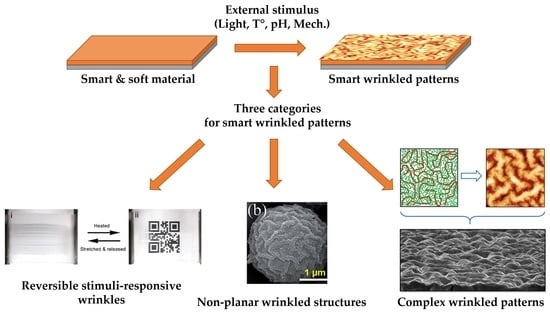Smart Polymer Surfaces with Complex Wrinkled Patterns: Reversible, Non-Planar, Gradient, and Hierarchical Structures
Abstract
:1. Introduction
1.1. Smart Polymers
1.2. Instability-Based Surface Patterning: Formation of Wrinkled Polymer Surfaces
2. Desing of Adaptive Wrinkled Patterned Surfaces: Reversible Stimuli-Responsive Wrinkle Formation
2.1. Light-Responsive Wrinkled Patterned Surfaces
2.2. Alternatives for the Fabrication of pH-Responsive Wrinkled Surfaces
2.3. Wrinkle Formation in Systems Incorporating Temperature-Responsive Polymers
2.4. Electro-Magnetical Response
2.5. Mechanical (Stress/Stretch) Response
2.6. Chemical Reaction/Gas/Solvent Response
3. Non-Planar Wrinkled Structures
3.1. Solid Core-Shell Spheres
3.2. Solid Core-Shell Cylinders
3.3. Hollow Spheres
3.4. Cylindrical Tubes
4. Complex Wrinkles Patterns
4.1. Strategies for Fabricated Gradient Wrinkle Surfaces
4.2. Hierarchically Ordered Wrinkled Surfaces
5. Conclusions and Future Perspectives
Author Contributions
Funding
Institutional Review Board Statement
Informed Consent Statement
Data Availability Statement
Conflicts of Interest
References
- Yu, C.; O’Brien, K.; Zhang, Y.-H.; Yu, H.; Jiang, H. Tunable optical gratings based on buckled nanoscale thin films on transparent elastomeric substrates. Appl. Phys. Lett. 2010, 96, 041111. [Google Scholar] [CrossRef]
- Peng, Y.; Serfass, C.M.; Kawazoe, A.; Shao, Y.; Gutierrez, K.; Hill, C.N.; Santos, V.J.; Visell, Y.; Hsiao, L.C. Elastohydrodynamic friction of robotic and human fingers on soft micropatterned substrates. Nat. Mater. 2021, 20, 1707–1711. [Google Scholar] [CrossRef] [PubMed]
- Peng, Y.; Serfass, C.M.; Hill, C.N.; Hsiao, L.C. Bending of Soft Micropatterns in Elastohydrodynamic Lubrication Tribology. Exp. Mech. 2021, 61, 969–979. [Google Scholar] [CrossRef]
- Schlaak, H.F.; Jungmann, M.; Matysek, M.; Lotz, P. Novel multilayer electrostatic solid state actuators with elastic dielectric (Invited Paper). In Smart Structures and Materials 2005: Electroactive Polymer Actuators and Devices (EAPAD); Bar-Cohen, Y., Ed.; SPIE: Paris, France, 2005; p. 121. [Google Scholar]
- Ren, K.; Liu, S.; Lin, M.; Wang, Y.; Zhang, Q.M. A compact electroactive polymer actuator suitable for refreshable Braille display. Sensors Actuators A Phys. 2008, 143, 335–342. [Google Scholar] [CrossRef]
- Shivapooja, P.; Wang, Q.; Orihuela, B.; Rittschof, D.; López, G.P.; Zhao, X. Bioinspired Surfaces with Dynamic Topography for Active Control of Biofouling. Adv. Mater. 2013, 25, 1430–1434. [Google Scholar] [CrossRef]
- Chung, J.Y.; Youngblood, J.P.; Stafford, C.M. Anisotropic wetting on tunable micro-wrinkled surfaces. Soft Matter 2007, 3, 1163–1169. [Google Scholar] [CrossRef]
- Chan, E.P.; Smith, E.J.; Hayward, R.C.; Crosby, A.J. Surface wrinkles for smart adhesion. Adv. Mater. 2008, 20, 711–716. [Google Scholar] [CrossRef]
- Qian, Y.; Zhang, X.; Xie, L.; Qi, D.; Chandran, B.K.; Chen, X.; Huang, W. Stretchable Organic Semiconductor Devices. Adv. Mater. 2016, 28, 9243–9265. [Google Scholar] [CrossRef]
- Qian, Y.; Zhang, X.; Qi, D.; Xie, L.; Chandran, B.K.; Chen, X.; Huang, W. Thin-film organic semiconductor devices: From flexibility to ultraflexibility. Sci. China Mater. 2016, 59, 589–608. [Google Scholar] [CrossRef]
- González-Henríquez, C.; Sarabia-Vallejos, M.; Rodriguez-Hernandez, J. Advances in the Fabrication of Antimicrobial Hydrogels for Biomedical Applications. Materials 2017, 10, 232. [Google Scholar] [CrossRef] [Green Version]
- Shu, T.; Hu, L.; Shen, Q.; Jiang, L.; Zhang, Q.; Serpe, M.J. Stimuli-responsive polymer-based systems for diagnostic applications. J. Mater. Chem. B 2020, 8, 7042–7061. [Google Scholar] [CrossRef]
- Saleh, T.A.; Fadillah, G.; Ciptawati, E. Smart advanced responsive materials, synthesis methods and classifications: From Lab to applications. J. Polym. Res. 2021, 28, 197. [Google Scholar] [CrossRef]
- Jingcheng, L.; Reddy, V.S.; Jayathilaka, W.A.D.M.; Chinnappan, A.; Ramakrishna, S.; Ghosh, R. Intelligent polymers, fibers and applications. Polymers 2021, 13, 1427. [Google Scholar] [CrossRef]
- Holman, H.; Kavarana, M.N.; Rajab, T.K. Smart materials in cardiovascular implants: Shape memory alloys and shape memory polymers. Artif. Organs 2021, 45, 454–463. [Google Scholar] [CrossRef]
- Peponi, L.; Raquez, J.M. How Smart Are the Polymers? 1st ed.; Peponi, L., Raquez, J.-M., Eds.; Nova Science Publisher, Inc.: Hauppauge, NY, USA, 2018; ISBN 978-1-53613-960-0. [Google Scholar]
- Zhou, Y.; Huang, W.M.; Kang, S.F.; Wu, X.L.; Lu, H.B.; Fu, J.; Cui, H. From 3D to 4D printing: Approaches and typical applications. J. Mech. Sci. Technol. 2015, 29, 4281–4288. [Google Scholar] [CrossRef]
- Tibbits, S.; Cheung, K. Programmable materials for architectural assembly and automation. Assem. Autom. 2012, 32, 216–225. [Google Scholar] [CrossRef]
- Hu, Y.Y.; Huang, W.M. Elastic and elastic-plastic analysis of multilayer thin films:Closed-form solutions. J. Appl. Phys. 2004, 96, 4154–4160. [Google Scholar] [CrossRef]
- Huang, W.M.; Ding, Z.; Wang, C.C.; Wei, J.; Zhao, Y.; Purnawali, H. Shape memory materials. Mater. Today 2010, 13, 54–61. [Google Scholar] [CrossRef]
- Sun, L.; Huang, W.M.; Ding, Z.; Zhao, Y.; Wang, C.C.; Purnawali, H.; Tang, C. Stimulus-responsive shape memory materials: A review. Mater. Des. 2012, 33, 577–640. [Google Scholar] [CrossRef]
- Hornbogen, E. Comparison of Shape Memory Metals and Polymers. Adv. Eng. Mater. 2006, 8, 101–106. [Google Scholar] [CrossRef]
- El Feninat, F.; Laroche, G.; Fiset, M.; Mantovani, D. Shape Memory Materials for Biomedical Applications. Adv. Eng. Mater. 2002, 4, 91–104. [Google Scholar] [CrossRef]
- Gunes, I.S.; Jana, S.C. Shape Memory Polymers and Their Nanocomposites: A Review of Science and Technology of New Multifunctional Materials. J. Nanosci. Nanotechnol. 2008, 8, 1616–1637. [Google Scholar] [CrossRef] [PubMed]
- Sarangi, M.K.; Rao, M.E.B.; Parcha, V. Smart polymers for colon targeted drug delivery systems: A review. Int. J. Polym. Mater. Polym. Biomater. 2020, 70, 1130–1166. [Google Scholar] [CrossRef]
- Tan, L.; Davis, A.C.; Cappelleri, D.J. Smart Polymers for Microscale Machines. Adv. Funct. Mater. 2021, 31, 1–56. [Google Scholar] [CrossRef]
- Rodríguez-Hernández, J. Wrinkled interfaces: Taking advantage of surface instabilities to pattern polymer surfaces. Prog. Polym. Sci. 2015, 42, 1–41. [Google Scholar] [CrossRef] [Green Version]
- Cerda, E.A.; Ravi-Chandar, K.; Mahadevan, L. Thin films. Wrinkling of an elastic sheet under tension. Nature 2002, 419, 579–580. [Google Scholar] [CrossRef]
- Efimenko, K.; Rackaitis, M.; Manias, E.; Vaziri, A.; Mahadevan, L.; Genzer, J. Nested self-similar wrinkling patterns in skins. Nat. Mater. 2005, 4, 293–297. [Google Scholar] [CrossRef]
- Dimmock, R.L.; Wang, X.; Fu, Y.; El Haj, A.J.; Yang, Y. Biomedical Applications of Wrinkling Polymers. Recent Prog. Mater. 2020, 2, 1–31. [Google Scholar] [CrossRef] [Green Version]
- Raj, S.S.; Mathew, R.M.; Nair, Y.; Aruna, S.T.; Vinod, T.P. Fabrication and Applications of Wrinkled Soft Substrates: An Overview. ChemistrySelect 2022, 7, e202200714. [Google Scholar] [CrossRef]
- Li, Z.; Zhai, Y.; Wang, Y.; Wendland, G.M.; Yin, X.; Xiao, J. Harnessing Surface Wrinkling–Cracking Patterns for Tunable Optical Transmittance. Adv. Opt. Mater. 2017, 5, 1700425. [Google Scholar] [CrossRef]
- Chen, W.; Gui, X.; Yang, L.; Zhu, H.; Tang, Z. Wrinkling of two-dimensional materials: Methods, properties and applications. Nanoscale Horiz. 2019, 4, 291–320. [Google Scholar] [CrossRef]
- González-Henríquez, C.M.; Rodríguez-Hernández, J. Wrinkled Polymer Surfaces; Springer International Publishing: Cham, Switzerland, 2019; ISBN 978-3-030-05122-8. [Google Scholar]
- Yang, S.; Khare, K.; Lin, P.C. Harnessing surface wrinkle patterns in soft matter. Adv. Funct. Mater. 2010, 20, 2550–2564. [Google Scholar] [CrossRef]
- Deng, S.; Berry, V. Wrinkled, rippled and crumpled graphene: An overview of formation mechanism, electronic properties, and applications. Mater. Today 2016, 19, 197–212. [Google Scholar] [CrossRef]
- Chung, J.Y.; Nolte, A.J.; Stafford, C.M. Surface wrinkling: A versatile platform for measuring thin-film properties. Adv. Mater. 2011, 23, 349–368. [Google Scholar] [CrossRef]
- Hou, H.; Yin, J.; Jiang, X. Smart Patterned Surface with Dynamic Wrinkles. Acc. Chem. Res. 2019, 52, 1025–1035. [Google Scholar] [CrossRef]
- Zhang, H.; Zhu, H.; Liang, X.; Liu, P.; Zhang, Q.; Zhu, S. Wrinkled smart surfaces: Enhanced switchable wettability and directional liquid transportation. Appl. Surf. Sci. 2020, 513, 145810. [Google Scholar] [CrossRef]
- Wang, Y.; Kim, B.J.; Peng, B.; Li, W.; Wang, Y.; Li, M.; Omenetto, F.G. Controlling silk fibroin conformation for dynamic, responsive, multifunctional, micropatterned surfaces. Proc. Natl. Acad. Sci. USA 2019, 116, 21361–21368. [Google Scholar] [CrossRef] [Green Version]
- Li, F.; Hou, H.; Yin, J.; Jiang, X. Multi-responsive wrinkling patterns by the photoswitchable supramolecular network. ACS Macro Lett. 2017, 6, 848–853. [Google Scholar] [CrossRef]
- Zong, C.; Zhao, Y.; Ji, H.; Han, X.; Xie, J.; Wang, J.; Cao, Y.-P.; Jiang, S.; Lu, C. Tuning and Erasing Surface Wrinkles by Reversible Visible-Light-Induced Photoisomerization. Angew. Chem.-Int. Ed. 2016, 55, 3931–3935. [Google Scholar] [CrossRef]
- Wang, J.; Zheng, Y.; Li, L.; Liu, E.; Zong, C.; Zhao, J.; Xie, J.; Xu, F.; König, T.A.F.; Saphiannikova, M.G.; et al. All-Optical Reversible Azo-Based Wrinkling Patterns with High Aspect Ratio and Polarization-Independent Orientation for Light-Responsive Soft Photonics. ACS Appl. Mater. Interfaces 2019, 11, 25595–25604. [Google Scholar] [CrossRef]
- Ma, T.; Li, T.; Zhou, L.; Ma, X.; Yin, J.; Jiang, X. Dynamic wrinkling pattern exhibiting tunable fluorescence for anticounterfeiting applications. Nat. Commun. 2020, 11, 1811. [Google Scholar] [CrossRef] [PubMed] [Green Version]
- Zong, C.; Azhar, U.; Zhou, C.; Wang, J.; Zhang, L.; Cao, Y.; Zhang, S.; Jiang, S.; Lu, C. Photocontrollable Wrinkle Morphology Evolution on Azo-Based Multilayers for Hierarchical Surface Micropatterns Fabrication. Langmuir 2019, 35, 2601–2609. [Google Scholar] [CrossRef] [PubMed]
- Xu, L.; Azhar, U.; Chen, Z.; Niu, Q.; Chen, J.; Zhao, X.; Zhang, S.; Zong, C. Light-printable epoxy oligomer wrinkle-forming surface for rewritable information storage. RSC Adv. 2020, 10, 3416–3423. [Google Scholar] [CrossRef] [PubMed]
- Li, F.; Hou, H.; Yin, J.; Jiang, X. Near-infrared light–responsive dynamic wrinkle patterns. Sci. Adv. 2018, 4, eaar5762. [Google Scholar] [CrossRef] [PubMed] [Green Version]
- Xie, M.; Xu, F.; Zhang, L.; Yin, J.; Jiang, X. Reversible Surface Dual-Pattern with Simultaneously Dynamic Wrinkled Topography and Fluorescence. ACS Macro Lett. 2018, 7, 540–545. [Google Scholar] [CrossRef]
- Hou, H.; Hu, K.; Lin, H.; Forth, J.; Zhang, W.; Russell, T.P.; Yin, J.; Jiang, X. Reversible Surface Patterning by Dynamic Crosslink Gradients: Controlling Buckling in 2D. Adv. Mater. 2018, 30, 1803463. [Google Scholar] [CrossRef]
- Zong, C.; Zhao, Y.; Ji, H.; Xie, J.; Han, X.; Wang, J.; Cao, Y.-P.; Lu, C.; Li, H.; Jiang, S. Patterning Surfaces on Azo-Based Multilayer Films via Surface Wrinkling Combined with Visible Light Irradiation. Macromol. Rapid Commun. 2016, 37, 1288–1294. [Google Scholar] [CrossRef]
- Xie, M.; Lin, G.; Ge, D.; Yang, L.; Zhang, L.; Yin, J.; Jiang, X. Pattern Memory Surface (PMS) with Dynamic Wrinkles for Unclonable Anticounterfeiting. ACS Mater. Lett. 2019, 1, 77–82. [Google Scholar] [CrossRef]
- Bae, H.J.; Bae, S.; Park, C.; Han, S.; Kim, J.; Kim, L.N.; Kim, K.; Song, S.H.; Park, W.; Kwon, S. Biomimetic microfingerprints for anti-counterfeiting strategies. Adv. Mater. 2015, 27, 2083–2089. [Google Scholar] [CrossRef]
- Zhou, L.; Hu, K.; Zhang, W.; Meng, G.; Yin, J.; Jiang, X. Regulating surface wrinkles using light. Natl. Sci. Rev. 2020, 7, 1247–1257. [Google Scholar] [CrossRef] [Green Version]
- Wang, B.; Wang, J.; Han, X.; Lu, C. Light-Induced Surface Wrinkling on Azo-Based Composite Films. Coatings 2022, 12, 608. [Google Scholar] [CrossRef]
- Bai, J.; Hu, K.; Zhang, L.; Shi, Z.; Zhang, W.; Yin, J.; Jiang, X. The Evolution of Self-Wrinkles in a Single-Layer Gradient Polymer Film Based on Viscoelasticity. Macromolecules 2022, 55, 3563–3572. [Google Scholar] [CrossRef]
- Um, E.; Cho, Y.-K.; Jeong, J. Spontaneous Wrinkle Formation on Hydrogel Surfaces Using Photoinitiator Diffusion from Oil–Water Interface. ACS Appl. Mater. Interfaces 2021, 13, 15837–15846. [Google Scholar] [CrossRef]
- Li, Y.; Li, X.; Guo, W.; Wu, M.; Sun, J. Spontaneous wrinkling of layer-by-layer assembled polyelectrolyte films for humidity-responsive superhydrophobicity. Sci. China Chem. 2016, 59, 1568–1573. [Google Scholar] [CrossRef]
- Hou, J.; Li, Q.; Han, X.; Lu, C. Swelling/Deswelling-Induced Reversible Surface Wrinkling on Layer-by-Layer Multilayers. J. Phys. Chem. B 2014, 118, 14502–14509. [Google Scholar] [CrossRef]
- Yang, J.; Hu, D.; Li, W.; Jia, Y.; Li, P. Formation mechanism of zigzag patterned P(NIPAM-co-AA)/CuS composite microspheres by in situ biomimetic mineralization for morphology modulation. RSC Adv. 2021, 11, 37904–37916. [Google Scholar] [CrossRef]
- Zeng, S.; Li, R.; Freire, S.G.; Garbellotto, V.M.M.; Huang, E.Y.; Smith, A.T.; Hu, C.; Tait, W.R.T.; Bian, Z.; Zheng, G.; et al. Moisture-Responsive Wrinkling Surfaces with Tunable Dynamics. Adv. Mater. 2017, 29, 1700828. [Google Scholar] [CrossRef]
- Tokudome, Y.; Kuniwaki, H.; Suzuki, K.; Carboni, D.; Poologasundarampillai, G.; Takahashi, M. Thermoresponsive Wrinkles on Hydrogels for Soft Actuators. Adv. Mater. Interfaces 2016, 3, 1500802. [Google Scholar] [CrossRef]
- Ringsdorf, H.; Venzmer, J.; Winnik, F.M. Fluorescence studies of hydrophobically modified poly(N-isopropylacrylamides). Macromolecules 1991, 24, 1678–1686. [Google Scholar] [CrossRef]
- Wang, Y.; Xiao, J. Programmable, reversible and repeatable wrinkling of shape memory polymer thin films on elastomeric substrates for smart adhesion. Soft Matter 2017, 13, 5317–5323. [Google Scholar] [CrossRef]
- Jiang, B.; Liu, L.; Gao, Z.; Feng, Z.; Zheng, Y.; Wang, W. Fast Dual-Stimuli-Responsive Dynamic Surface Wrinkles with High Bistability for Smart Windows and Rewritable Optical Displays. ACS Appl. Mater. Interfaces 2019, 11, 40406–40415. [Google Scholar] [CrossRef] [PubMed]
- Wang, Y.; Villada, A.; Zhai, Y.; Zou, Z.; Chen, Y.; Yin, X.; Xiao, J. Tunable surface wrinkling on shape memory polymers with application in smart micromirror. Appl. Phys. Lett. 2019, 114, 193701. [Google Scholar] [CrossRef]
- Lee, D.-H.; Yun, G.-T.; Doo, G.; Yuk, S.; Guim, H.; Kim, Y.; Jung, W.-B.; Jung, H.-T.; Kim, H.-T. Hierarchical Wrinkle-Structured Catalyst Layer/Membrane Interface for Ultralow Pt-Loading Polymer Electrolyte Membrane Fuel Cells (PEMFCs). Nano Lett. 2022, 22, 1174–1182. [Google Scholar] [CrossRef] [PubMed]
- Van den Ende, D.; Kamminga, J.-D.; Boersma, A.; Andritsch, T.; Steeneken, P.G. Voltage-Controlled Surface Wrinkling of Elastomeric Coatings. Adv. Mater. 2013, 25, 3438–3442. [Google Scholar] [CrossRef]
- Lin, I.-T.; Choi, Y.S.; Wojcik, C.; Wang, T.; Kar-Narayan, S.; Smoukov, S.K. Electro-responsive surfaces with controllable wrinkling patterns for switchable light reflection–diffusion–grating devices. Mater. Today 2020, 41, 51–61. [Google Scholar] [CrossRef]
- Psarra, E.; Bodelot, L.; Danas, K. Wrinkling to crinkling transitions and curvature localization in a magnetoelastic film bonded to a non-magnetic substrate. J. Mech. Phys. Solids 2019, 133, 103734. [Google Scholar] [CrossRef] [Green Version]
- Bodelot, L.; Voropaieff, J.-P.; Pössinger, T. Experimental investigation of the coupled magneto-mechanical response in magnetorheological elastomers. Exp. Mech. 2018, 58, 207–221. [Google Scholar] [CrossRef]
- Jiang, B.; Liu, L.; Gao, Z.; Wang, W. A General and Robust Strategy for Fabricating Mechanoresponsive Surface Wrinkles with Dynamic Switchable Transmittance. Adv. Opt. Mater. 2018, 6, 1800195. [Google Scholar] [CrossRef]
- Li, Z.; Liu, Y.; Marin, M.; Yin, Y. Thickness-dependent wrinkling of PDMS films for programmable mechanochromic responses. Nano Res. 2020, 13, 1882–1888. [Google Scholar] [CrossRef]
- Oyefusi, A.; Chen, J. Mechanical approaches to dynamic, reversible mechanochromism based on thin film interference. Appl. Mater. Today 2020, 20, 100774. [Google Scholar] [CrossRef]
- Baek, S.; Jang, H.; Kim, S.Y.; Jeong, H.; Han, S.; Jang, Y.; Kim, D.H.; Lee, H.S. Flexible piezocapacitive sensors based on wrinkled microstructures: Toward low-cost fabrication of pressure sensors over large areas. RSC Adv. 2017, 7, 39420–39426. [Google Scholar] [CrossRef] [Green Version]
- Yu, S.; Li, L.; Wang, J.; Liu, E.; Zhao, J.; Xu, F.; Cao, Y.; Lu, C. Light-Boosting Highly Sensitive Pressure Sensors Based on Bioinspired Multiscale Surface Structures. Adv. Funct. Mater. 2020, 30, 1907091. [Google Scholar] [CrossRef]
- Ouchi, T.; Hayward, R.C. Harnessing Multiple Surface Deformation Modes for Switchable Conductivity Surfaces. ACS Appl. Mater. Interfaces 2020, 12, 10031–10038. [Google Scholar] [CrossRef]
- Kashihara, Y.; Asoh, T.; Uyama, H. Travelling Wave Generation of Wrinkles on the Hydrogel Surfaces. Macromol. Rapid Commun. 2022, 43, 2100848. [Google Scholar] [CrossRef]
- Wawryk, M.M.H.; Turpin, G.A.; Tabor, R.F. Surface defects on wrinkled PDMS induce droplet anisotropy. Colloids Surfaces A Physicochem. Eng. Asp. 2022, 639, 128317. [Google Scholar] [CrossRef]
- Vandeparre, H.; Damman, P. Wrinkling of Stimuloresponsive Surfaces: Mechanical Instability Coupled to Diffusion. Phys. Rev. Lett. 2008, 101, 124301. [Google Scholar] [CrossRef] [Green Version]
- Oscurato, S.L.; Formisano, F.; de Lisio, C.; D’Ischia, M.; Gesuele, F.; Maddalena, P.; Manini, P.; Migliaccio, L.; Pezzella, A. Spontaneous wrinkle emergence in nascent eumelanin thin films. Soft Matter 2019, 15, 9261–9270. [Google Scholar] [CrossRef]
- El Haitami, A.; Bretagnol, F.; Assuid, P.; Petitet, G.; Cantournet, S.; Corté, L. Erasable and reversible wrinkling of halogenated rubber surfaces. Langmuir 2013, 29, 15664–15672. [Google Scholar] [CrossRef]
- Zhang, Y.; Fu, Q.; Cui, Y.; Mu, R.; Jin, L.; Bao, X. Enhanced reactivity of graphene wrinkles and their function as nanosized gas inlets for reactions under graphene. Phys. Chem. Chem. Phys. 2013, 15, 19042. [Google Scholar] [CrossRef]
- Hou, H.; Yin, J.; Jiang, X. Reversible Diels–Alder Reaction to Control Wrinkle Patterns: From Dynamic Chemistry to Dynamic Patterns. Adv. Mater. 2016, 28, 9126–9132. [Google Scholar] [CrossRef]
- Qu, C.; Wang, S.; Liu, L.; Bai, Y.; Li, L.; Sun, F.; Hao, M.; Li, T.; Lu, Q.; Li, L.; et al. Bioinspired Flexible Volatile Organic Compounds Sensor Based on Dynamic Surface Wrinkling with Dual-Signal Response. Small 2019, 15, 1900216. [Google Scholar] [CrossRef] [PubMed]
- Su, X.; Li, H.; Lai, X.; Chen, Z.; Zeng, X. Stimuli-responsive superhydrophobic films driven by solvent vapor for electric switch and liquid manipulation. Chem. Eng. J. 2020, 394, 124919. [Google Scholar] [CrossRef]
- Kim, H.S.; Crosby, A.J. Solvent-responsive surface via wrinkling instability. Adv. Mater. 2011, 23, 4188–4192. [Google Scholar] [CrossRef] [PubMed]
- Zhao, Y.; Zhu, H.; Jiang, C.; Cao, Y.; Feng, X.Q. Wrinkling pattern evolution on curved surfaces. J. Mech. Phys. Solids 2020, 135, 103798. [Google Scholar] [CrossRef]
- Wang, T.; Yang, Y.; Fu, C.; Liu, F.; Wang, K.; Xu, F. Wrinkling and smoothing of a soft shell. J. Mech. Phys. Solids 2020, 134, 103738. [Google Scholar] [CrossRef]
- Cutolo, A.; Pagliarulo, V.; Merola, F.; Coppola, S.; Ferraro, P.; Fraldi, M. Wrinkling prediction, formation and evolution in thin films adhering on polymeric substrata. Mater. Des. 2020, 187, 108314. [Google Scholar] [CrossRef]
- Kundu, S.; Davis, C.S.; Long, T.; Sharma, R.; Crosby, A.J. Adhesion of nonplanar wrinkled surfaces. J. Polym. Sci. Part B Polym. Phys. 2011, 49, 179–185. [Google Scholar] [CrossRef]
- Lin, P.-C.; Vajpayee, S.; Jagota, A.; Hui, C.-Y.; Yang, S. Mechanically tunable dry adhesive from wrinkled elastomers. Soft Matter 2008, 4, 1830. [Google Scholar] [CrossRef]
- Li, B.; Jia, F.; Cao, Y.-P.; Feng, X.-Q.; Gao, H. Surface wrinkling patterns on a core-shell soft sphere. Phys. Rev. Lett. 2011, 106, 2–5. [Google Scholar] [CrossRef]
- Gao, N.; Zhang, X.; Liao, S.; Jia, H.; Wang, Y. Polymer Swelling Induced Conductive Wrinkles for an Ultrasensitive Pressure Sensor. ACS Macro Lett. 2016, 5, 823–827. [Google Scholar] [CrossRef]
- Xu, J.; Liu, Z.; Wang, J.; Liu, P.; Ahmad, M.; Zhang, Q.; Zhang, B. Preparation of core-shell C@TiO2 composite microspheres with wrinkled morphology and its microwave absorption. J. Colloid Interface Sci. 2022, 607, 1036–1049. [Google Scholar] [CrossRef]
- Yang, J.-L.; Zhao, S.-X.; Lu, Y.-M.; Zeng, X.-T.; Lv, W.; Cao, G.-Z. ZnS spheres wrapped by an ultrathin wrinkled carbon film as a multifunctional interlayer for long-life Li–S batteries. J. Mater. Chem. A 2020, 8, 231–241. [Google Scholar] [CrossRef]
- Im, J.; Yoo, D.; Kim, J.; Yoon, S.; Cho, K.Y. One-Step Spontaneous Formation of Dual Wrinkling on Uniform-Sized Microparticles Induced by Surface. Macromol. Chem. Phys. 2017, 218, 1700152. [Google Scholar] [CrossRef]
- Ziarati, A.; Badiei, A.; Luque, R.; Ouyang, W. Designer hydrogenated wrinkled yolk@shell TiO2 architectures towards advanced visible light photocatalysts for selective alcohol oxidation. J. Mater. Chem. A 2018, 6, 8962–8968. [Google Scholar] [CrossRef] [Green Version]
- Peymanfar, R.; Ahmadi, A.; Selseleh-Zakerin, E.; Ghaffari, A.; Mojtahedi, M.M.; Sharifi, A. Electromagnetic and optical characteristics of wrinkled Ni nanostructure coated on carbon microspheres. Chem. Eng. J. 2021, 405, 126985. [Google Scholar] [CrossRef]
- Sun, X.; Li, Y. Colloidal Carbon Spheres and Their Core/Shell Structures with Noble-Metal Nanoparticles. Angew. Chem. Int. Ed. 2004, 43, 597–601. [Google Scholar] [CrossRef]
- Cao, Y.-P.; Jia, F.; Zhao, Y.; Feng, X.-Q.; Yu, S.-W. Buckling and post-buckling of a stiff film resting on an elastic graded substrate. Int. J. Solids Struct. 2012, 49, 1656–1664. [Google Scholar] [CrossRef] [Green Version]
- Cao, Y.P.; Li, B.; Feng, X.Q. Surface wrinkling and folding of core-shell soft cylinders. Soft Matter 2012, 8, 556–562. [Google Scholar] [CrossRef]
- Wang, D.; Sheng, B.; Wu, X.; Huang, Y.; Peng, L.; Xu, B.; Li, B.; Ni, Z. Self-assembly ring wrinkles formed on the surface of polydimethylsiloxane cylinders. Mater. Res. Express 2019, 6, 095312. [Google Scholar] [CrossRef]
- Jia, F.; Pearce, S.P.; Goriely, A. Curvature delays growth-induced wrinkling. Phys. Rev. E 2018, 98, 033003. [Google Scholar] [CrossRef] [Green Version]
- Patrício, P.; Teixeira, P.I.C.; Trindade, A.C.; Godinho, M.H. Longitudinal versus polar wrinkling of core-shell fibers with anisotropic size mismatches. Phys. Rev. E 2014, 89, 012403. [Google Scholar] [CrossRef] [PubMed]
- Guo, J.; Niu, M.; Yang, C. Highly flexible and stretchable optical strain sensing for human motion detection. Optica 2017, 4, 1285. [Google Scholar] [CrossRef]
- Wang, A.; Zhu, Q.; Xing, Z. A functionalized chitosan wrinkled hollow sphere containing calcium ions: Efficient adsorption of sodium dodecylbenzenesulfonate (SDBS) from aqueous solutions. J. Colloid Interface Sci. 2019, 555, 203–213. [Google Scholar] [CrossRef] [PubMed]
- Wang, A.; Zhu, Q.; Xing, Z. Design and synthesis of a calcium modified quaternized chitosan hollow sphere for efficient adsorption of SDBS. J. Hazard. Mater. 2019, 369, 342–352. [Google Scholar] [CrossRef]
- Wang, L.; Wang, Y.; Tian, H.; Qiao, L.; Zeng, Y. Enhanced ammonia detection using wrinkled porous CoFe2O4 double-shelled spheres prepared by a thermally driven contraction process. Sensors Actuators B Chem. 2020, 314, 128085. [Google Scholar] [CrossRef]
- Han, X.Y.; Zhao, D.L.; Meng, W.J.; Yang, H.X.; Wu, Y.Q.; Gao, R.Z.; Yang, Y.; Pu, H. Hollow tremella-like graphene sphere/SnO2 composite for high performance Li-ion battery anodes. Ceram. Int. 2019, 45, 16244–16250. [Google Scholar] [CrossRef]
- Mohammadi Zardkhoshoui, A.; Hosseiny Davarani, S.S. Formation of graphene-wrapped multi-shelled NiGa2O4 hollow spheres and graphene-wrapped yolk–shell NiFe2O4 hollow spheres derived from metal–organic frameworks for high-performance hybrid supercapacitors. Nanoscale 2020, 12, 1643–1656. [Google Scholar] [CrossRef]
- Mohammadi Zardkhoshoui, A.; Hosseiny Davarani, S.S. Boosting the energy density of supercapacitors by encapsulating a multi-shelled zinc–cobalt-selenide hollow nanosphere cathode and a yolk–double shell cobalt–iron-selenide hollow nanosphere anode in a graphene network. Nanoscale 2020, 12, 12476–12489. [Google Scholar] [CrossRef]
- Wang, Z.; Jia, H.; Cai, Y.; Li, C.; Zheng, X.; Liang, H.; Qi, J.; Cao, J.; Feng, J. Highly conductive Mn3O4/MnS heterostructures building multi-shelled hollow microspheres for high-performance supercapacitors. Chem. Eng. J. 2020, 392, 123890. [Google Scholar] [CrossRef]
- Wang, S.; Xiong, Y.; Wang, X.; Liu, W.; Tian, J.; Wu, N.; Cui, H.; Wang, X. Surface-wrinkled SnO2 hollow microspheres decorated with AuAg bimetallic nanoparticles for triethylamine detection. Powder Technol. 2022, 22, 117457. [Google Scholar] [CrossRef]
- Li, X.; Wang, Y.; Cheng, P.; Liu, Y.; Zhang, Y.; Ma, J.; Lv, C. High-performance ethanol sensor of wrinkled microspheres by spray pyrolysis. Sensors Actuators B Chem. 2021, 344, 130309. [Google Scholar] [CrossRef]
- Niknam, E.; Naffakh-Moosavy, H.; Moosavifard, S.E.; Afshar, M.G. Multi-shelled bimetal V-doped Co3O4 hollow spheres derived from metal organic framework for high performance supercapacitors. J. Energy Storage 2021, 44, 103508. [Google Scholar] [CrossRef]
- Patrinoiu, G.; Rodriguez, J.R.; Wang, Y.; Birjega, R.; Osiceanu, P.; Musuc, A.M.; Qi, Z.; Wang, H.; Pol, V.G.; Calderon-Moreno, J.M.; et al. Versatile by design: Hollow Co3O4 architectures for superior lithium storage prepared by alternative green Pechini method. Appl. Surf. Sci. 2020, 510, 145431. [Google Scholar] [CrossRef]
- Geng, J.; Taibur Rahman, M.; Panat, R.; Li, L. Self-Assembled Axisymmetric Microscale Periodic Wrinkles on Elastomer Fibers. J. Micro Nano-Manuf. 2017, 5, 021006. [Google Scholar] [CrossRef]
- Yang, J.; Tang, J.; Guo, H.; Liu, W.; Shen, C.; Liu, J.; Qin, L. Fabrication of micron and submicron gratings by using plasma treatment on the curved polydimethylsiloxane surfaces. Opt. Mater. 2017, 72, 241–246. [Google Scholar] [CrossRef]
- Sampathkumar, K.; Androulidakis, C.; Koukaras, E.N.; Rahova, J.; Drogowska, K.; Kalbac, M.; Vetushka, A.; Fejfar, A.; Galiotis, C.; Frank, O. Sculpturing graphene wrinkle patterns into compliant substrates. Carbon 2019, 146, 772–778. [Google Scholar] [CrossRef]
- Zeng, S.; Li, R.; Tait, W.R.T.; Smith, A.T.; Zhang, M.; Zhu, M.; Chov, N.; Xu, G.; Zhang, D.; Sun, L. Spontaneous formation of wrinkle-driven tubular structure as a versatile platform for adaptive 3D stretchable electronics. Mater. Horiz. 2020, 7, 2368–2377. [Google Scholar] [CrossRef]
- Wen, X.; Sun, S.; Wu, P. Dynamic wrinkling of a hydrogel-elastomer hybrid microtube enables blood vessel-like hydraulic pressure sensing and flow regulation. Mater. Horiz. 2020, 7, 2150–2157. [Google Scholar] [CrossRef]
- Zhang, J.; Jian, Y.; Tong, J.; Deng, H.; Du, Y.; Shi, X. Hollow chitosan hydrogel tube with controllable wrinkled pattern via film-to-tube fabrication. Carbohydr. Polym. 2022, 287, 119333. [Google Scholar] [CrossRef]
- Jung, W.-B.; Cho, S.-Y.; Yun, G.-T.; Choi, J.; Kim, Y.; Kim, M.; Kang, H.; Jung, H.-T. Hierarchical Metal Oxide Wrinkles as Responsive Chemical Sensors. ACS Appl. Nano Mater. 2019, 2, 5520–5526. [Google Scholar] [CrossRef]
- Chang, T.-H.; Tian, Y.; Li, C.; Gu, X.; Li, K.; Yang, H.; Sanghani, P.; Lim, C.M.; Ren, H.; Chen, P.-Y. Stretchable Graphene Pressure Sensors with Shar-Pei-like Hierarchical Wrinkles for Collision-Aware Surgical Robotics. ACS Appl. Mater. Interfaces 2019, 11, 10226–10236. [Google Scholar] [CrossRef] [PubMed]
- Yan, J.; Ma, Y.; Li, X.; Zhang, C.; Cao, M.; Chen, W.; Luo, S.; Zhu, M.; Gao, Y. Flexible and high-sensitivity piezoresistive sensor based on MXene composite with wrinkle structure. Ceram. Int. 2020, 46, 23592–23598. [Google Scholar] [CrossRef]
- Li, K.; Wang, J.; Shao, B.; Xiao, J.; Zhou, H.; Yu, S. Wrinkling patterns of tantalum films on modulus-gradient compliant substrates. Thin Solid Films 2018, 654, 100–106. [Google Scholar] [CrossRef]
- Yu, S.; Sun, Y.; Li, S.; Ni, Y. Harnessing fold-to-wrinkle transition and hierarchical wrinkling on soft material surfaces by regulating substrate stiffness and sputtering flux. Soft Matter 2018, 14, 6745–6755. [Google Scholar] [CrossRef] [PubMed]
- Yu, S.; Ma, L.; Sun, Y.; Lu, C.; Zhou, H.; Ni, Y. Controlled Wrinkling Patterns in Periodic Thickness-Gradient Films on Polydimethylsiloxane Substrates. Langmuir 2019, 35, 7146–7154. [Google Scholar] [CrossRef]
- Lee, J.S.; Hong, H.; Park, S.J.; Lee, S.J.; Kim, D.S. A simple fabrication process for stepwise gradient wrinkle pattern with spatially-controlled wavelength based on sequential oxygen plasma treatment. Microelectron. Eng. 2017, 176, 101–105. [Google Scholar] [CrossRef]
- Kato, M.; Asoh, T.A.; Uyama, H. Electrophoretic fabrication of an active and selective wrinkle surface on hydrogels. Chem. Commun. 2019, 55, 4170–4173. [Google Scholar] [CrossRef]
- Liguori, G.R.; Zhou, Q.; Liguori, T.T.A.; Barros, G.G.; Kühn, P.T.; Moreira, L.F.P.; van Rijn, P.; Harmsen, M.C. Directional Topography Influences Adipose Mesenchymal Stromal Cell Plasticity: Prospects for Tissue Engineering and Fibrosis. Stem Cells Int. 2019, 2019, 5387850. [Google Scholar] [CrossRef] [Green Version]
- Yang, L.; Jurczak, K.M.; Ge, L.; Rijn, P. High-Throughput Screening and Hierarchical Topography-Mediated Neural Differentiation of Mesenchymal Stem Cells. Adv. Healthc. Mater. 2020, 9, 2000117. [Google Scholar] [CrossRef]
- Shen, Y.; Wang, Y.; Luo, Z.; Wang, B. Durable, Sensitive, and Wide-Range Wearable Pressure Sensors Based on Wavy-Structured Flexible Conductive Composite Film. Macromol. Mater. Eng. 2020, 305, 2000206. [Google Scholar] [CrossRef]
- Chai, H.; Tian, Y.; Yu, S.; Cao, B.; Peng, X.; Zhang, Z.; Liu, A.; Wu, H. Large-Range, Reversible Directional Spreading of Droplet on a Double-Gradient Wrinkled Surface Adjusted Under Mechanical Strain. Adv. Mater. Interfaces 2020, 7, 1901980. [Google Scholar] [CrossRef]
- Park, C.; Bae, H.J.; Yoon, J.; Song, S.W.; Jeong, Y.; Kim, K.; Kwon, S.; Park, W. Gradient-Wrinkled Microparticle with Grayscale Lithography Controlling the Cross-Linking Densities for High Security Level Anti-Counterfeiting Strategies. ACS Omega 2021, 6, 2121–2126. [Google Scholar] [CrossRef]
- Lee, W.K.; Bin Jung, W.; Nagel, S.R.; Odom, T.W. Stretchable superhydrophobicity from monolithic, three-dimensional hierarchical wrinkles. Nano Lett. 2016, 16, 3774–3779. [Google Scholar] [CrossRef]
- Wang, D.; Cheewaruangroj, N.; Li, Y.; McHale, G.; Jiang, Y.; Wood, D.; Biggins, J.S.; Xu, B. Bin Spatially Configuring Wrinkle Pattern and Multiscale Surface Evolution with Structural Confinement. Adv. Funct. Mater. 2017, 28, 1704228. [Google Scholar] [CrossRef]
- Li, X.; Guo, M.; Wang, F.; Shen, X.; Weng, Y.; Hu, Z. Controllable Hierarchical Surface Patterns of Supramolecular Hydrogels: Harnessing Buckling Instability by Confinement. Chem.-Eur. J. 2017, 23, 17444–17448. [Google Scholar] [CrossRef]
- González-Henríquez, C.M.; Rodríguez-Umanzor, F.E.; Guzmán, D.; Sarabia-Vallejos, M.A.; Rodríguez-Hernández, J. Formation of responsive hierarchical wrinkled patterns on hydrogel films via multi-step methodology. Polymer 2019, 179, 121662. [Google Scholar] [CrossRef]
- Kim, E.S.; Kim, S.H.; Lee, S.-J.; Lee, J.H.; Byeon, M.; Suh, D.H.; Choi, W.J. Facile fabrication of micro/nano-structured wrinkles by controlling elastic properties of polydimethylsiloxane substrates. Polymer 2021, 212, 123087. [Google Scholar] [CrossRef]
- Yu, S.; Sun, Y.; Zhang, X.; Lu, C.; Zhou, H.; Ni, Y. Hierarchical wrinkles and oscillatory cracks in metal films deposited on liquid stripes. Phys. Rev. E 2019, 99, 062802. [Google Scholar] [CrossRef]
- Zhou, H.; Sun, Y.; Jiao, Z.; Yu, S. Spontaneous hierarchical wrinkling of metal films sputter-deposited on liquid-like gel substrates. Thin Solid Films 2020, 707, 138075. [Google Scholar] [CrossRef]
- Li, Y.; Dai, S.; John, J.; Carter, K.R. Superhydrophobic Surfaces from Hierarchically Structured Wrinkled Polymers. ACS Appl. Mater. Interfaces 2013, 5, 11066–11073. [Google Scholar] [CrossRef]
- Wu, H.; Yu, S.; Xu, Z.; Cao, B.; Peng, X.; Zhang, Z.; Chai, G.; Liu, A. Theoretical and Experimental Study of Reversible and Stable Wetting States of a Hierarchically Wrinkled Surface Tuned by Mechanical Strain. Langmuir 2019, 35, 6870–6877. [Google Scholar] [CrossRef] [PubMed]
- Lin, G.; Chandrasekaran, P.; Lv, C.; Zhang, Q.; Tang, Y.; Han, L.; Yin, J. Self-similar Hierarchical Wrinkles as a Potential Multifunctional Smart Window with Simultaneously Tunable Transparency, Structural Color, and Droplet Transport. ACS Appl. Mater. Interfaces 2017, 9, 26510–26517. [Google Scholar] [CrossRef] [PubMed]
- Yang, C.; Li, L.; Zhao, J.; Wang, J.; Xie, J.; Cao, Y.; Xue, M.; Lu, C. Highly Sensitive Wearable Pressure Sensors Based on Three-Scale Nested Wrinkling Microstructures of Polypyrrole Films. ACS Appl. Mater. Interfaces 2018, 10, 25811–25818. [Google Scholar] [CrossRef] [PubMed]
- Qi, J.; Wang, A.C.; Yang, W.; Zhang, M.; Hou, C.; Zhang, Q.; Li, Y.; Wang, H. Hydrogel-based hierarchically wrinkled stretchable nanofibrous membrane for high performance wearable triboelectric nanogenerator. Nano Energy 2020, 67, 104206. [Google Scholar] [CrossRef]
- Wang, H.; Yan, G.; Cao, X.; Liu, Y.; Zhong, Y.; Cui, L.; Liu, J. Hierarchical Cu(OH)2@MnO2 core-shell nanorods array in situ generated on three-dimensional copper foam for high-performance supercapacitors. J. Colloid Interface Sci. 2020, 563, 394–404. [Google Scholar] [CrossRef]
- Kato, M.; Kashihara, Y.; Asoh, T.A.; Uyama, H. Geometry Control of Wrinkle Structures Aligned on Hydrogel Surfaces. Langmuir 2020, 36, 1467–1473. [Google Scholar] [CrossRef]
- Li, T.; Hu, K.; Ma, X.; Zhang, W.; Yin, J.; Jiang, X. Hierarchical 3D Patterns with Dynamic Wrinkles Produced by a Photocontrolled Diels–Alder Reaction on the Surface. Adv. Mater. 2020, 32, 1906712. [Google Scholar] [CrossRef]
- Hou, H.; Li, F.; Su, Z.; Yin, J.; Jiang, X. Light-reversible hierarchical patterns by dynamic photo-dimerization induced wrinkles. J. Mater. Chem. C 2017, 5, 8765–8773. [Google Scholar] [CrossRef]
- Zhou, L.; Ma, T.; Li, T.; Ma, X.; Yin, J.; Jiang, X. Dynamic Interpenetrating Polymer Network (IPN) Strategy for Multiresponsive Hierarchical Pattern of Reversible Wrinkle. ACS Appl. Mater. Interfaces 2019, 11, 15977–15985. [Google Scholar] [CrossRef]
- Yang, Y.; Duan, S.; Xiao, W.; Zhao, H. Silver nanowire-based stretchable strain sensors with hierarchical wrinkled structures. Sensors Actuators A Phys. 2022, 343, 113653. [Google Scholar] [CrossRef]


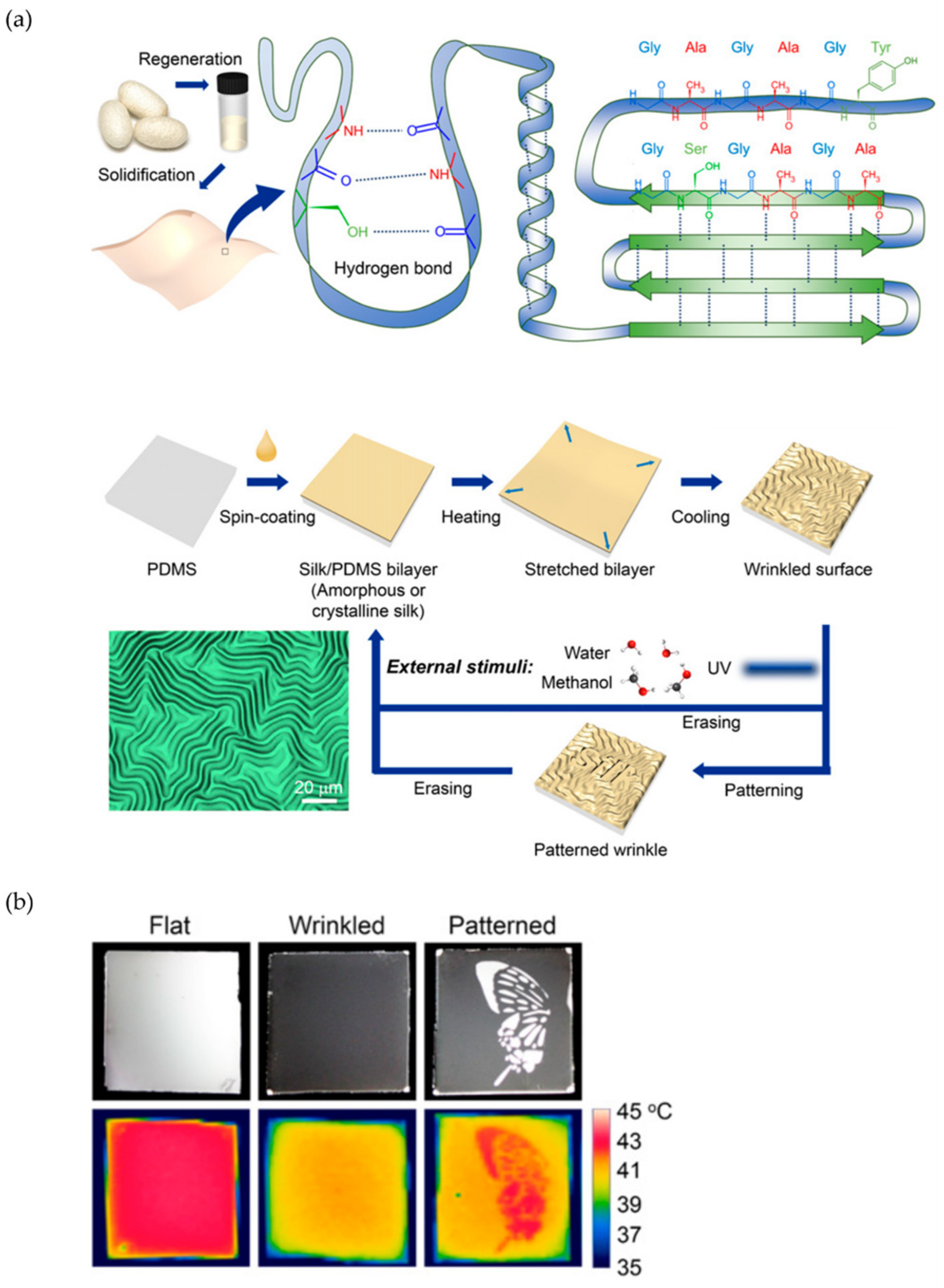
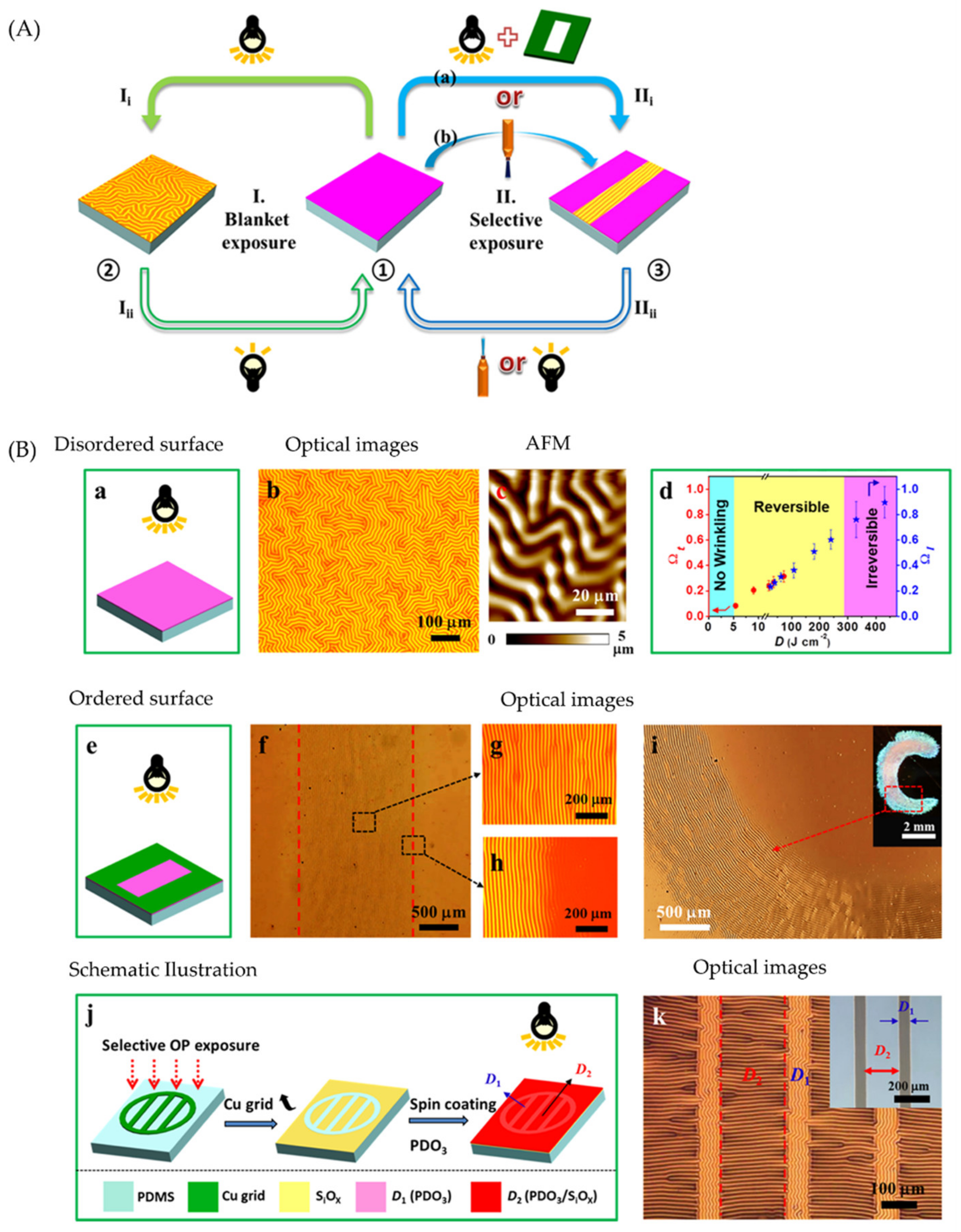




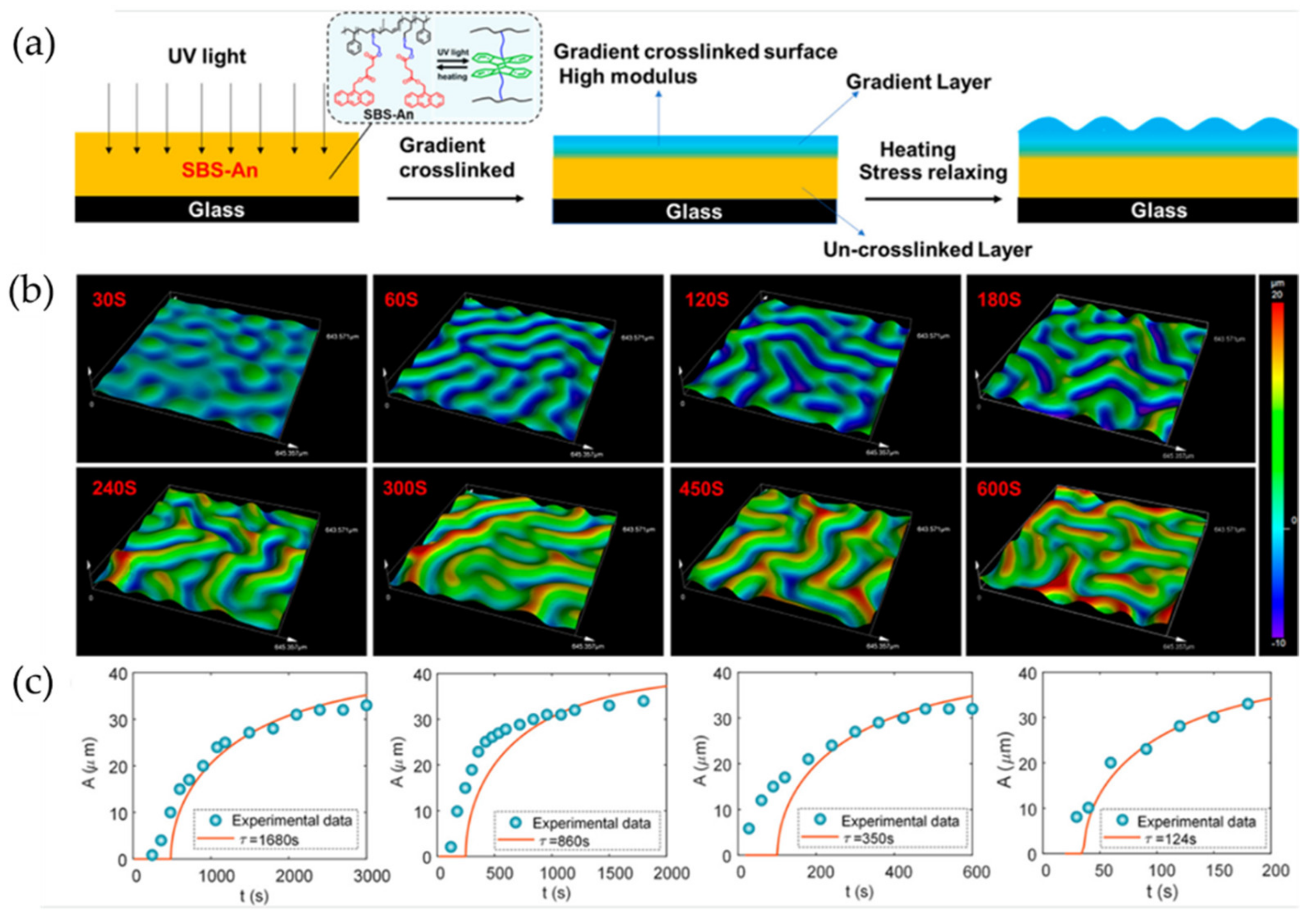
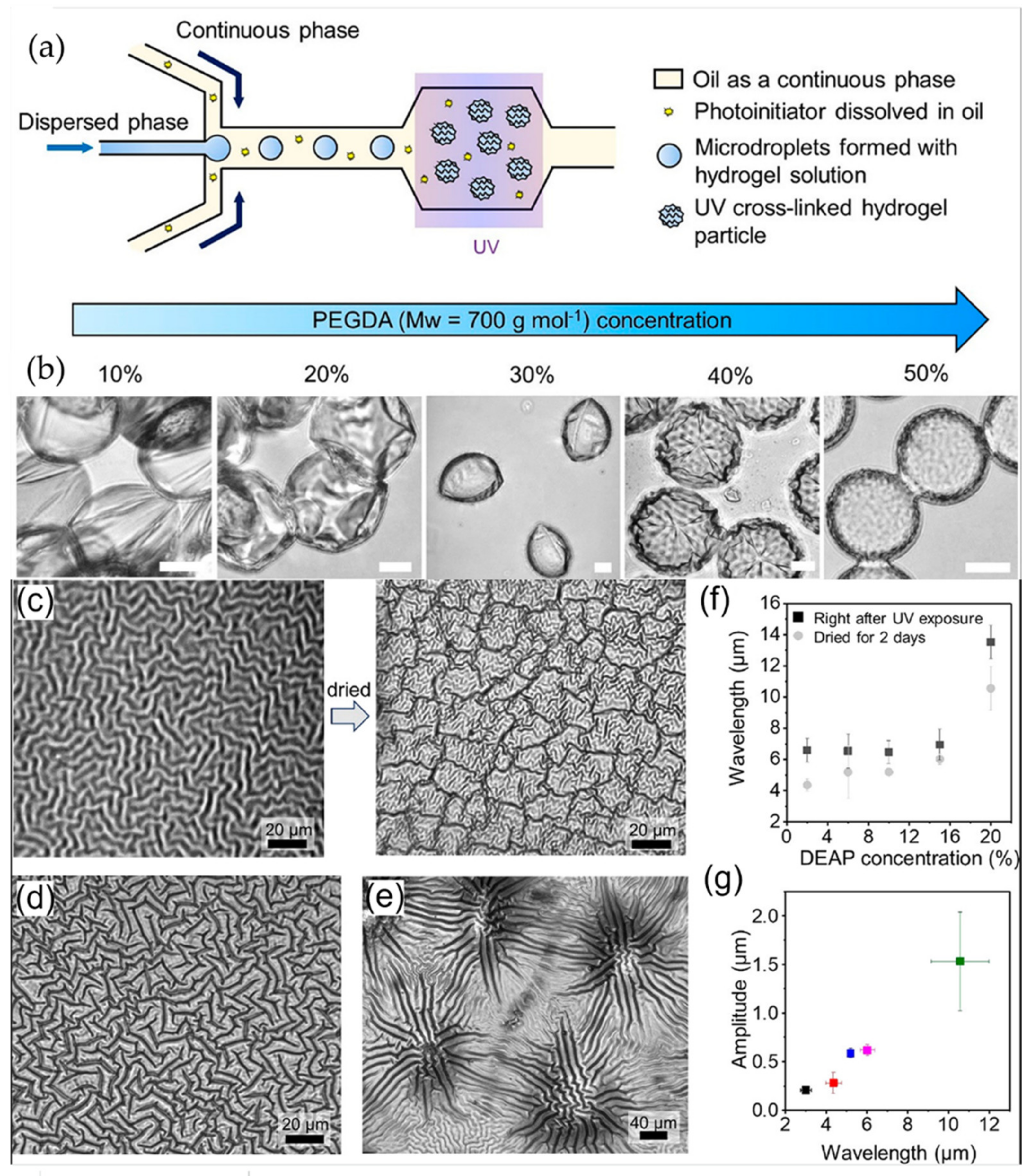


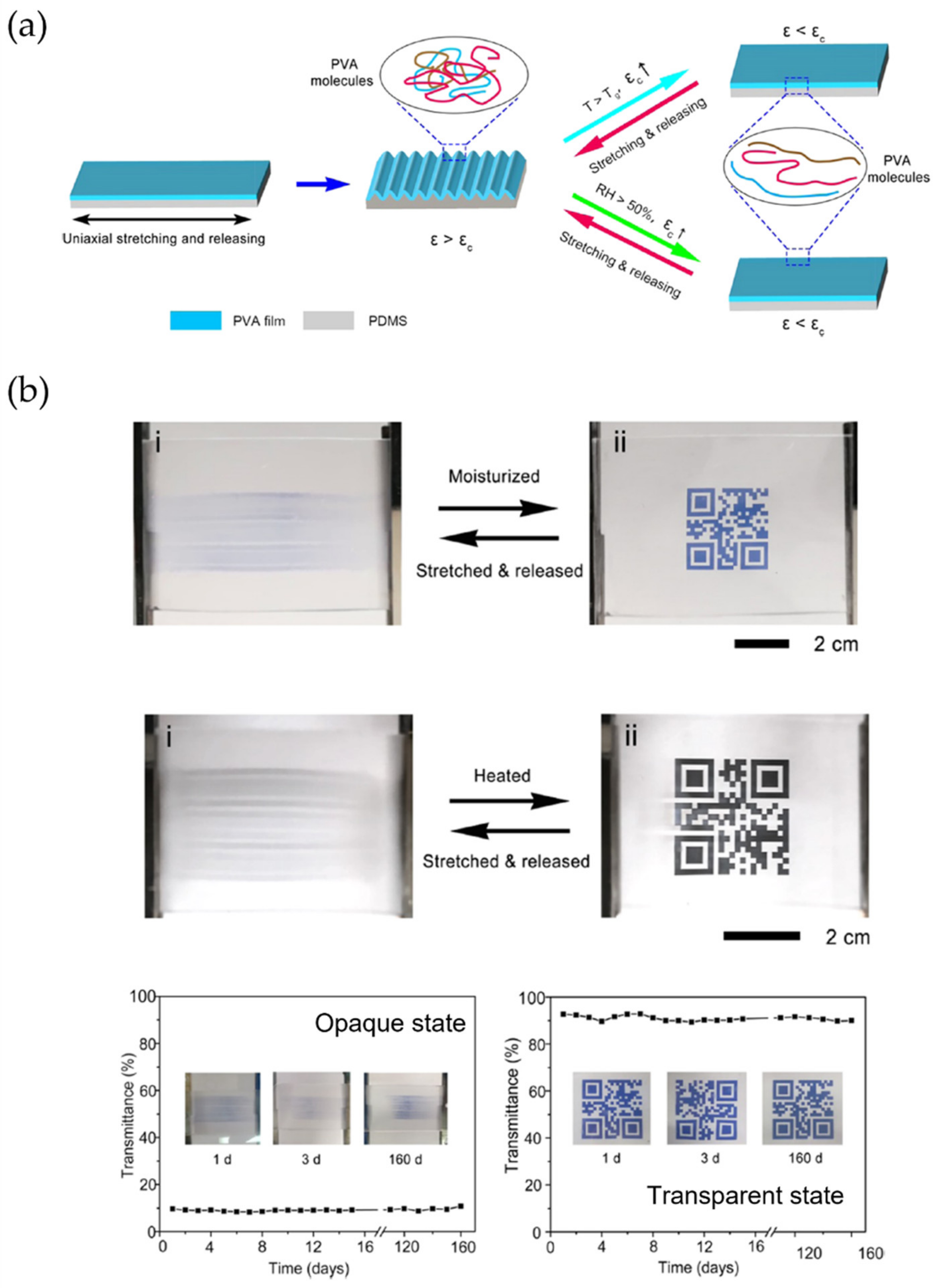

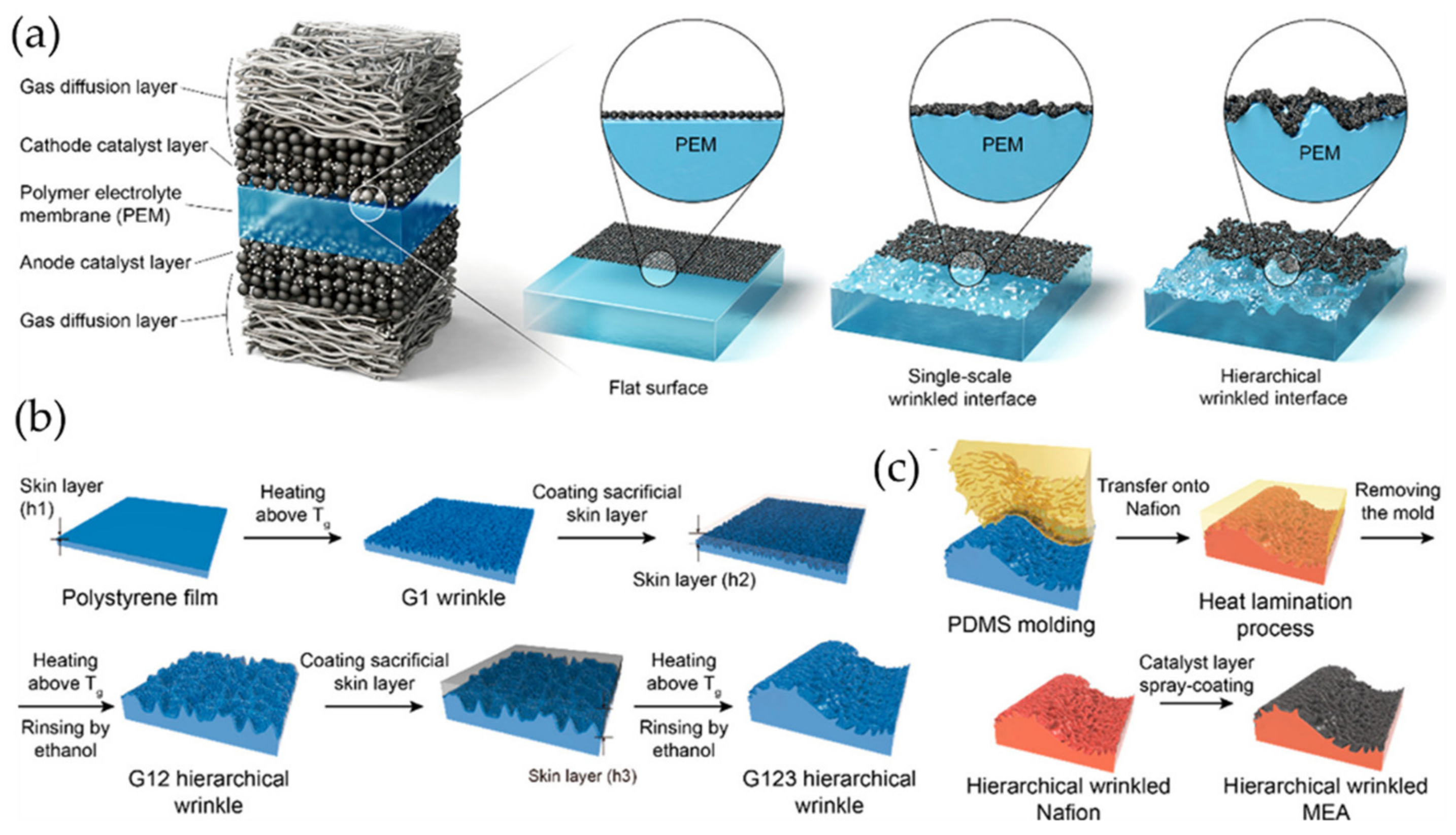
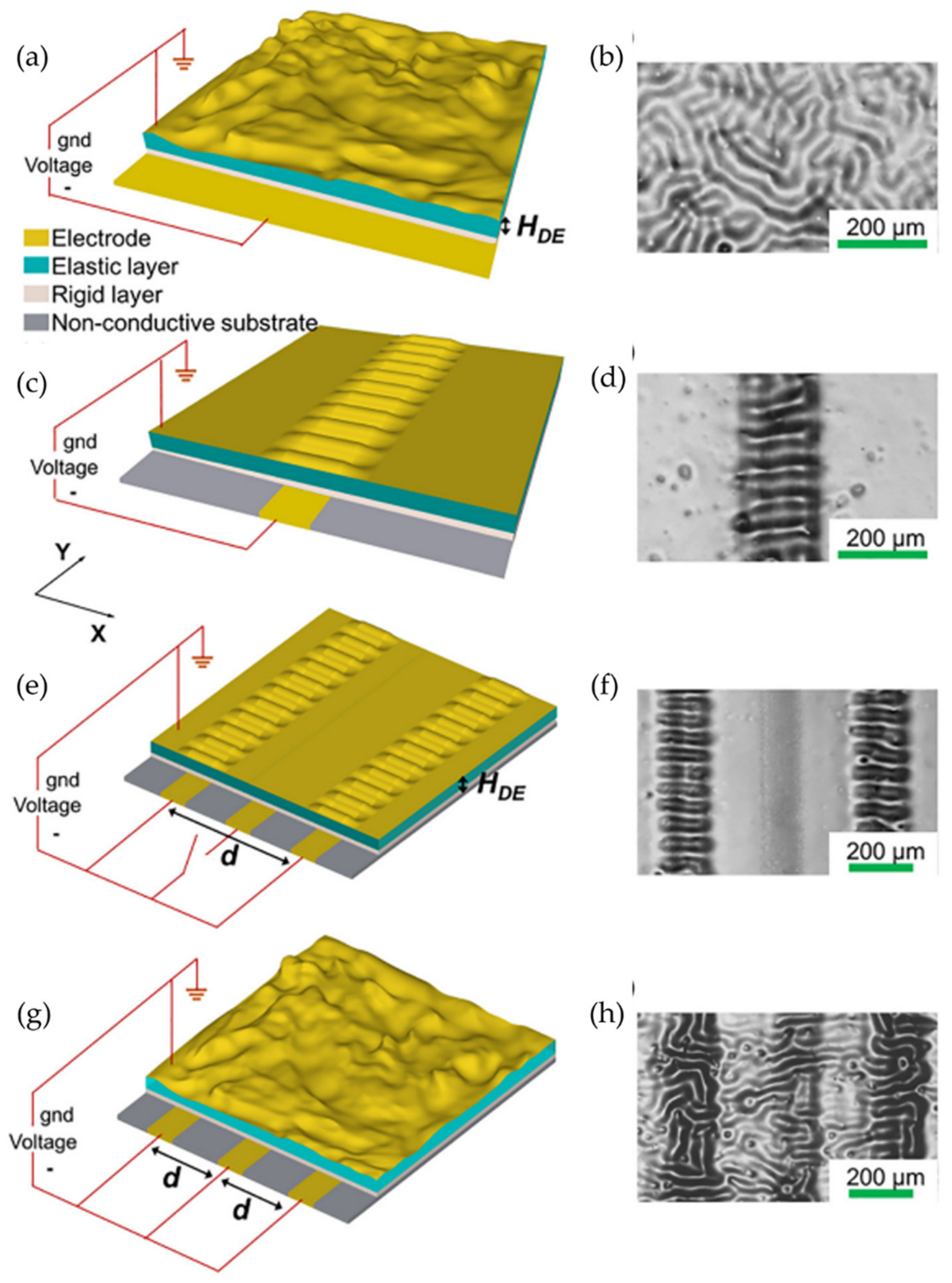

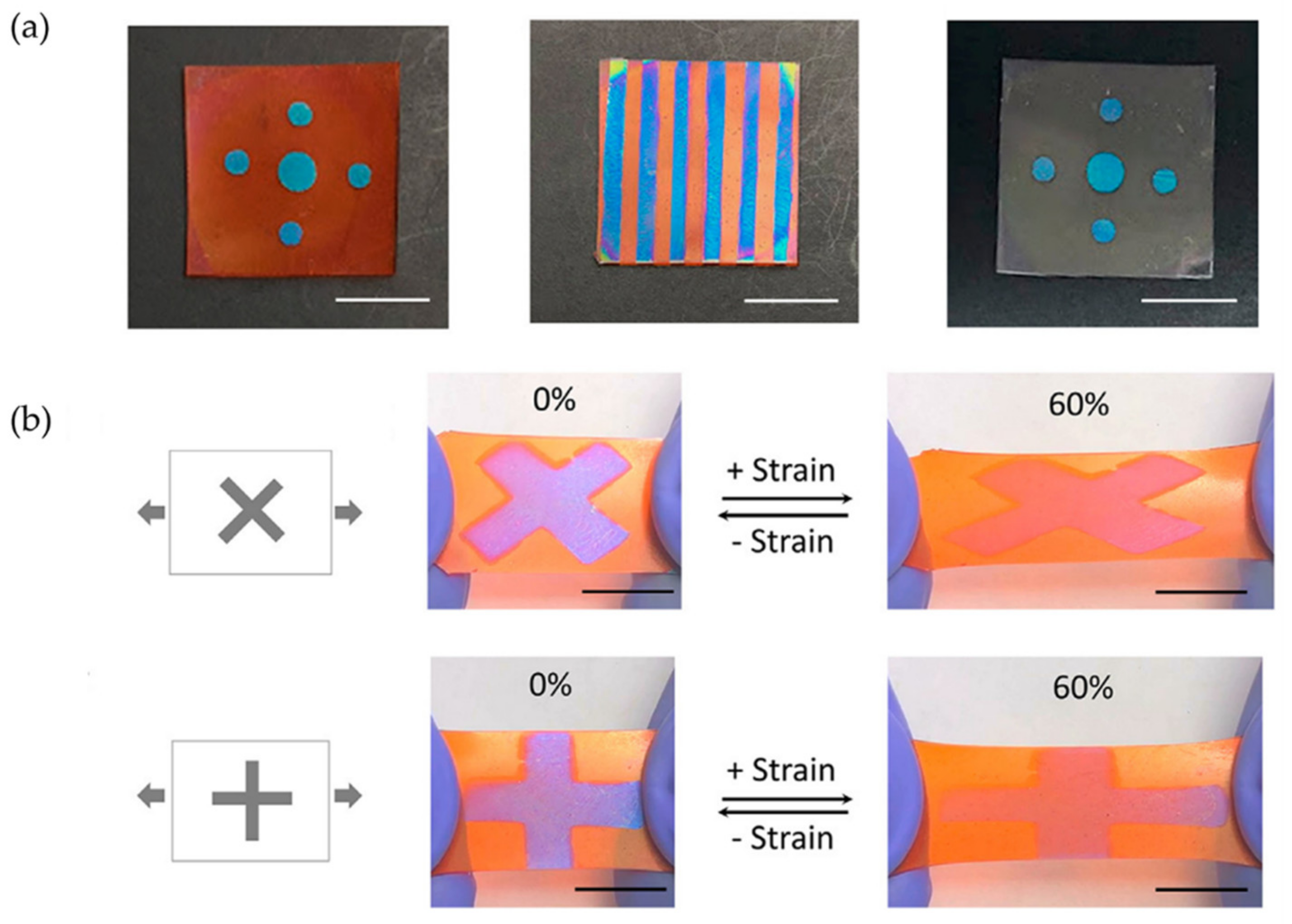
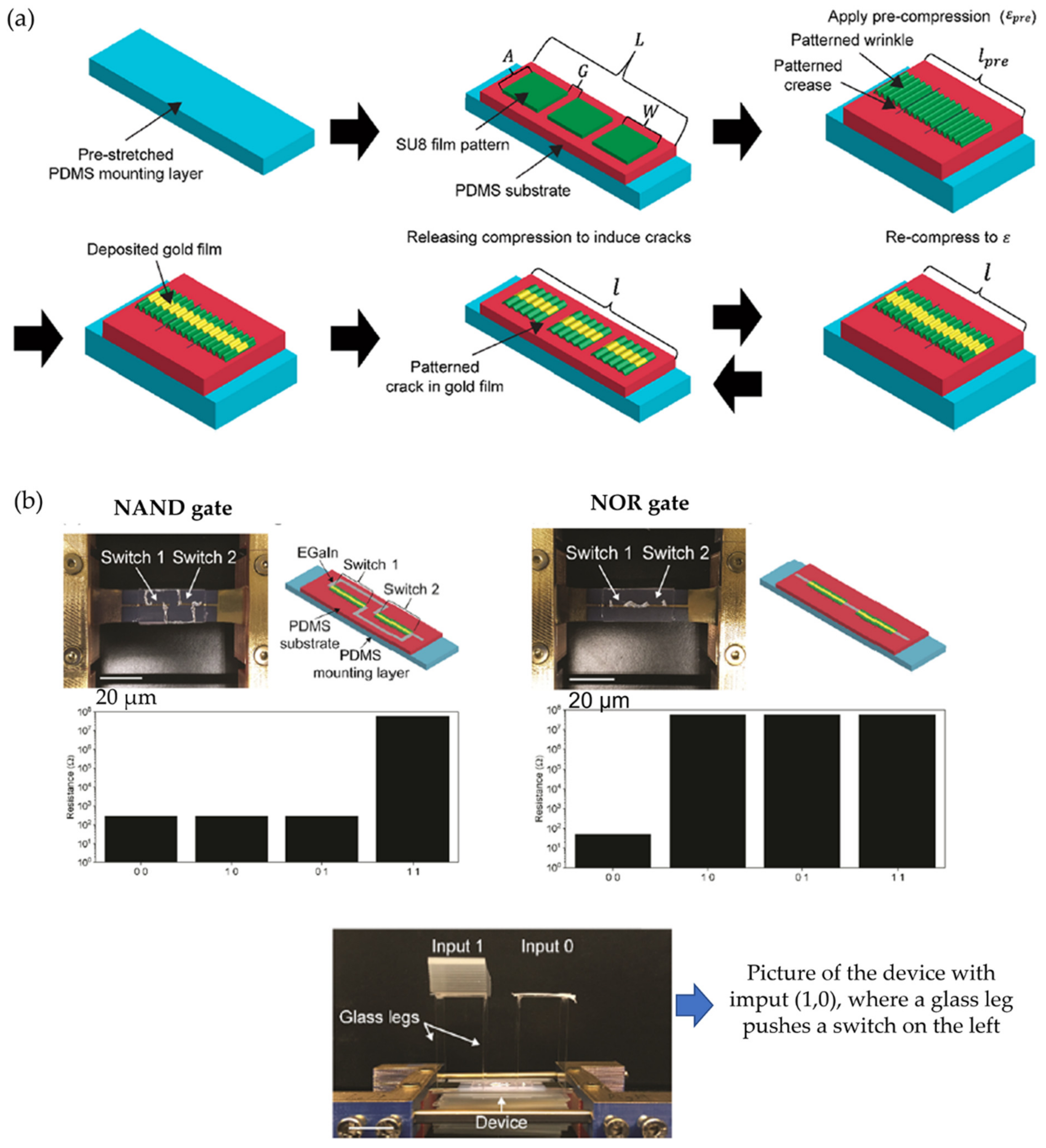

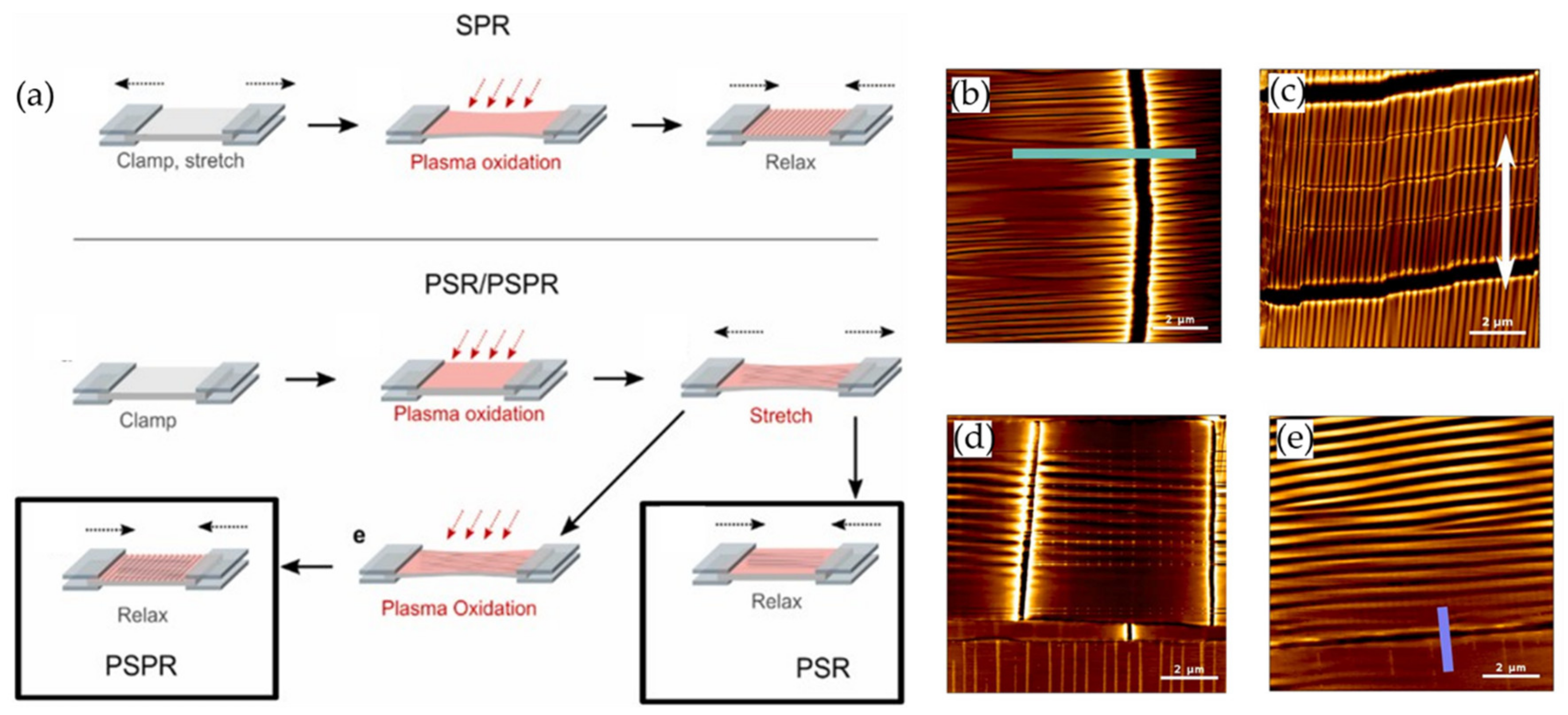
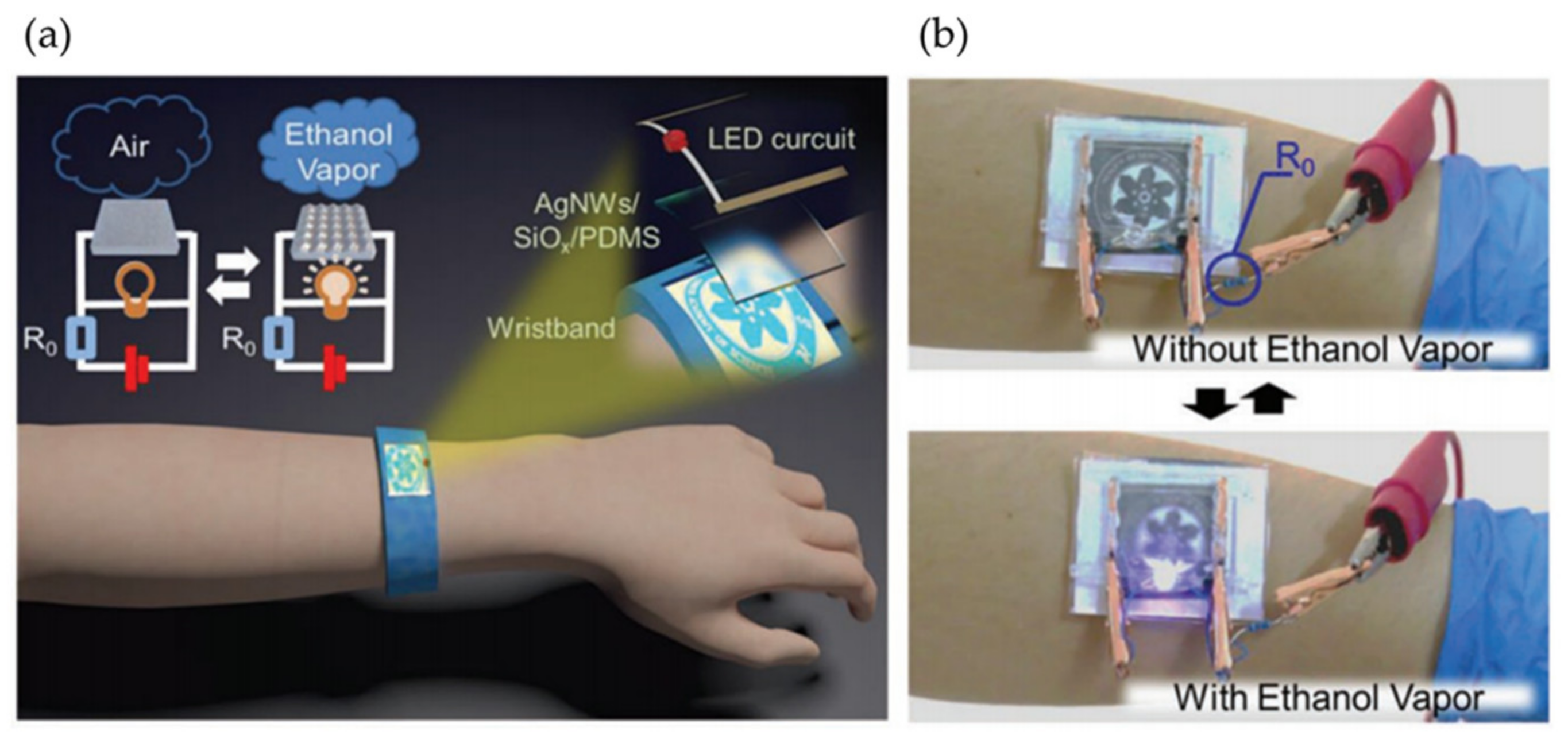




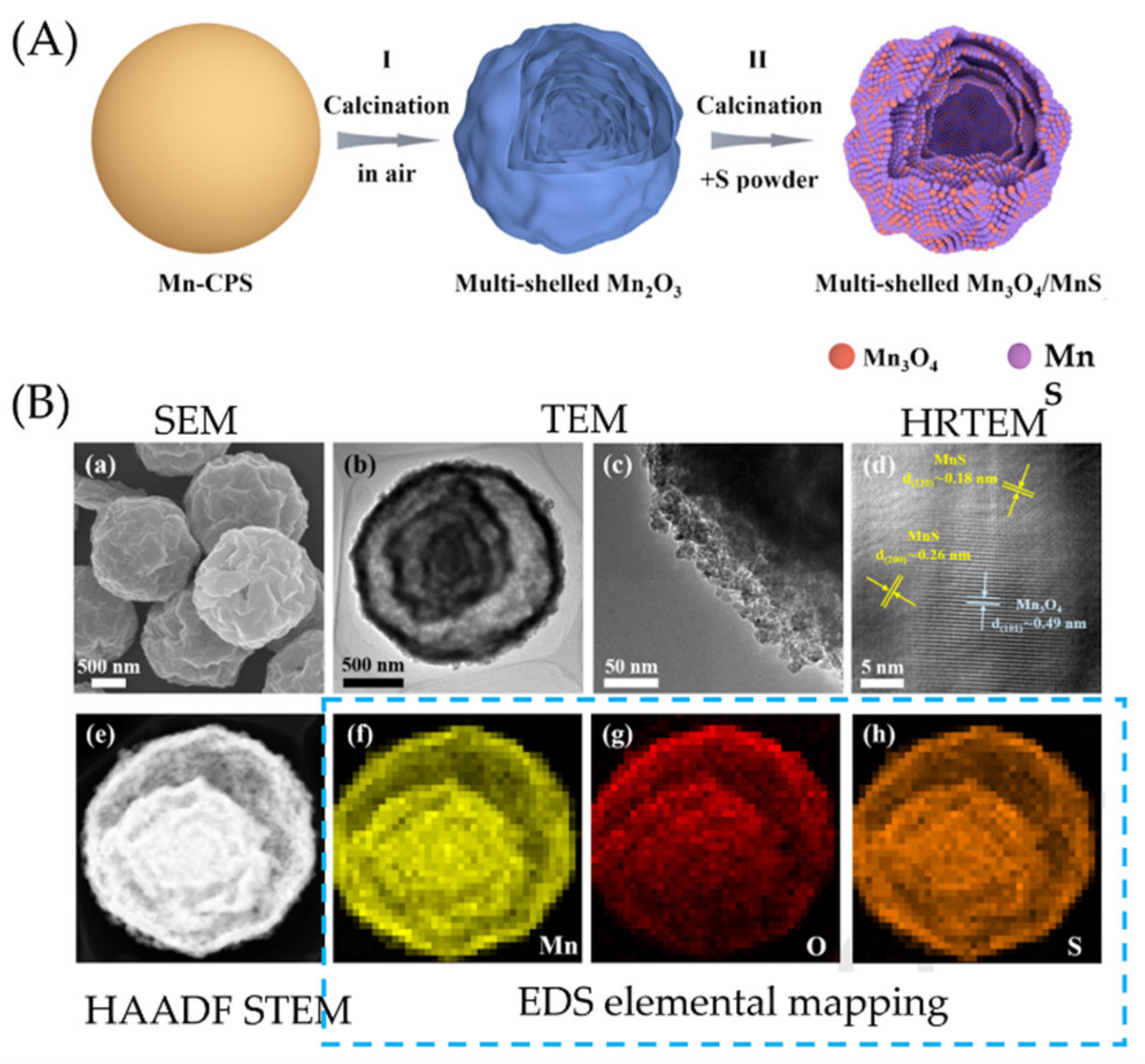


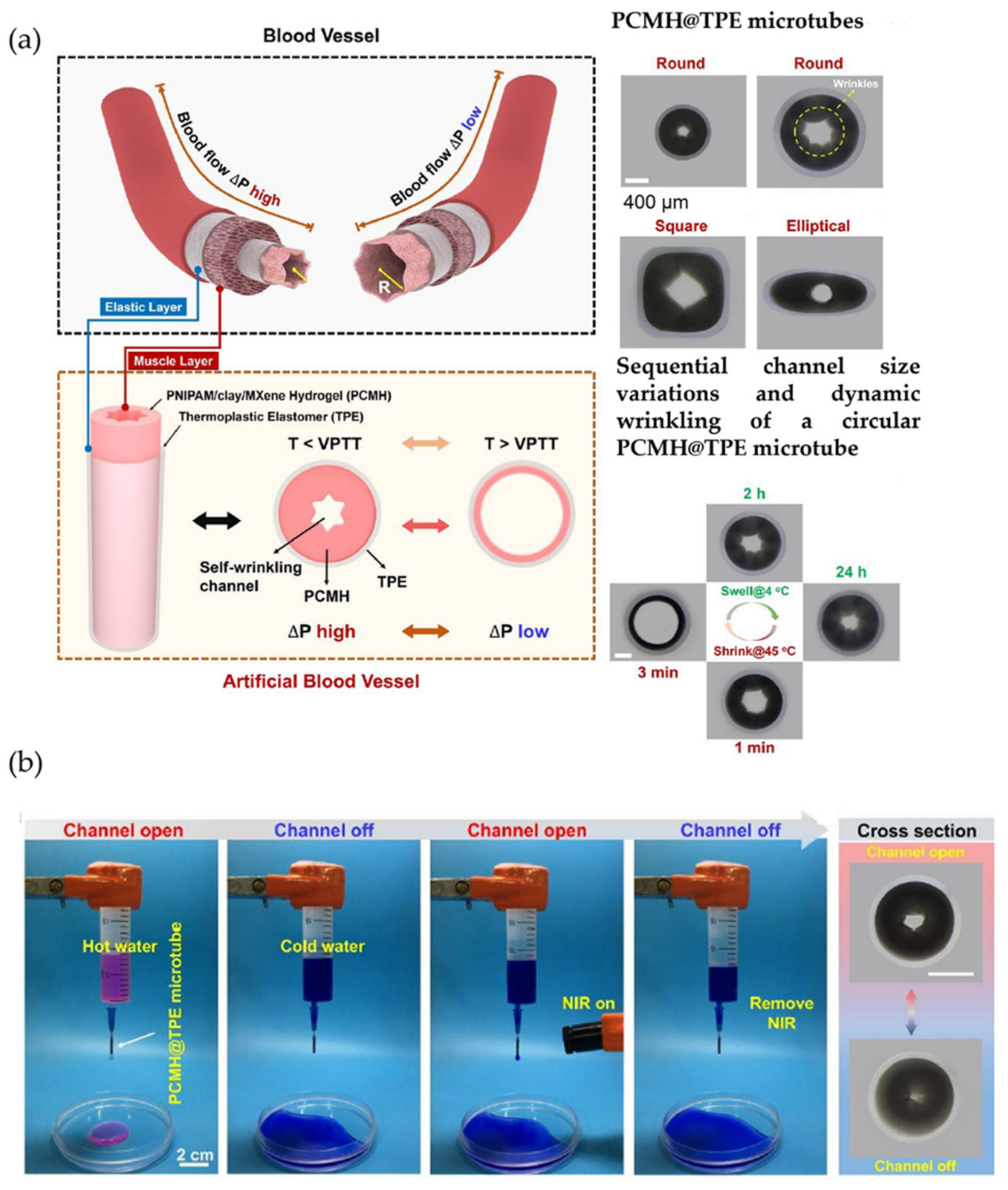

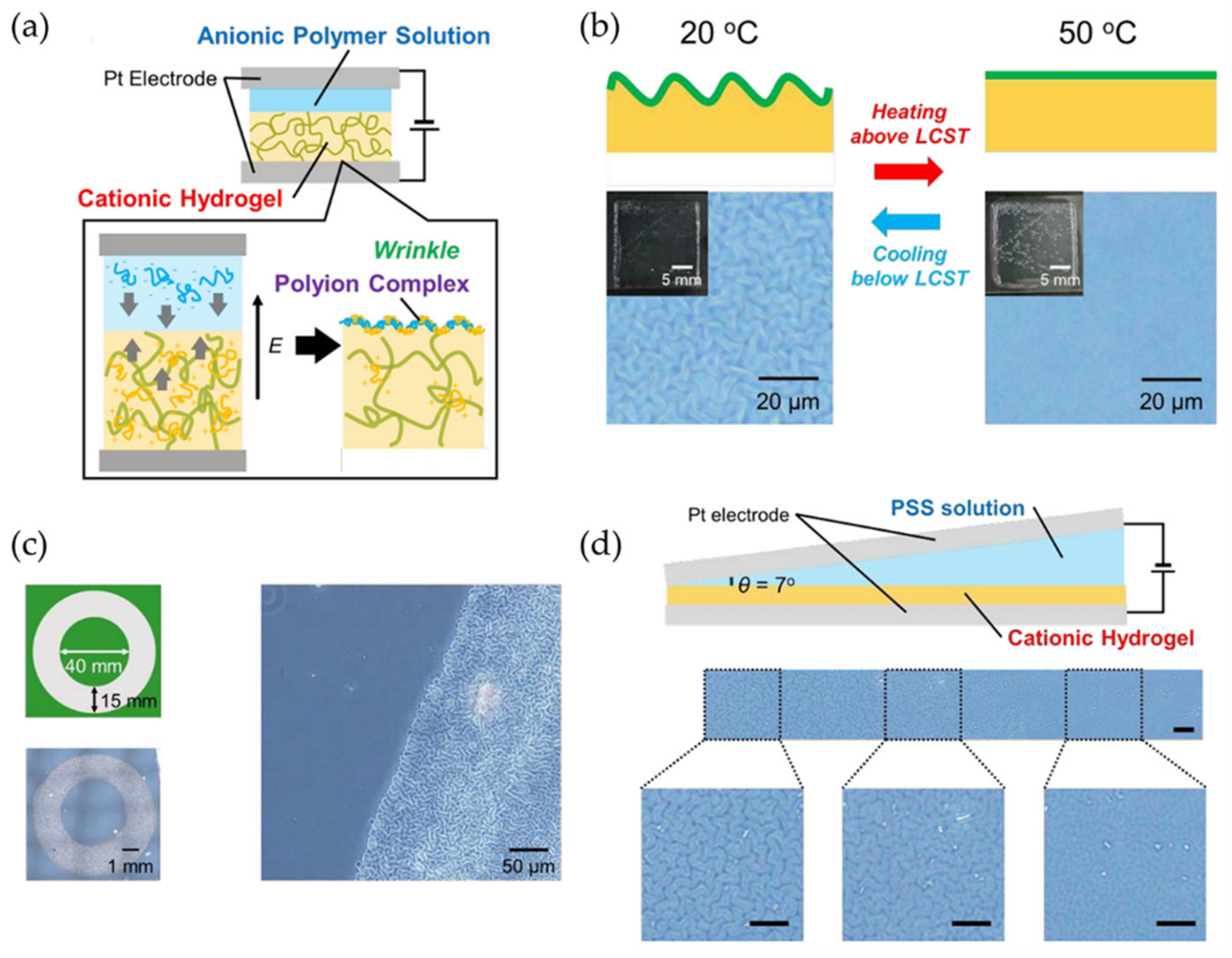


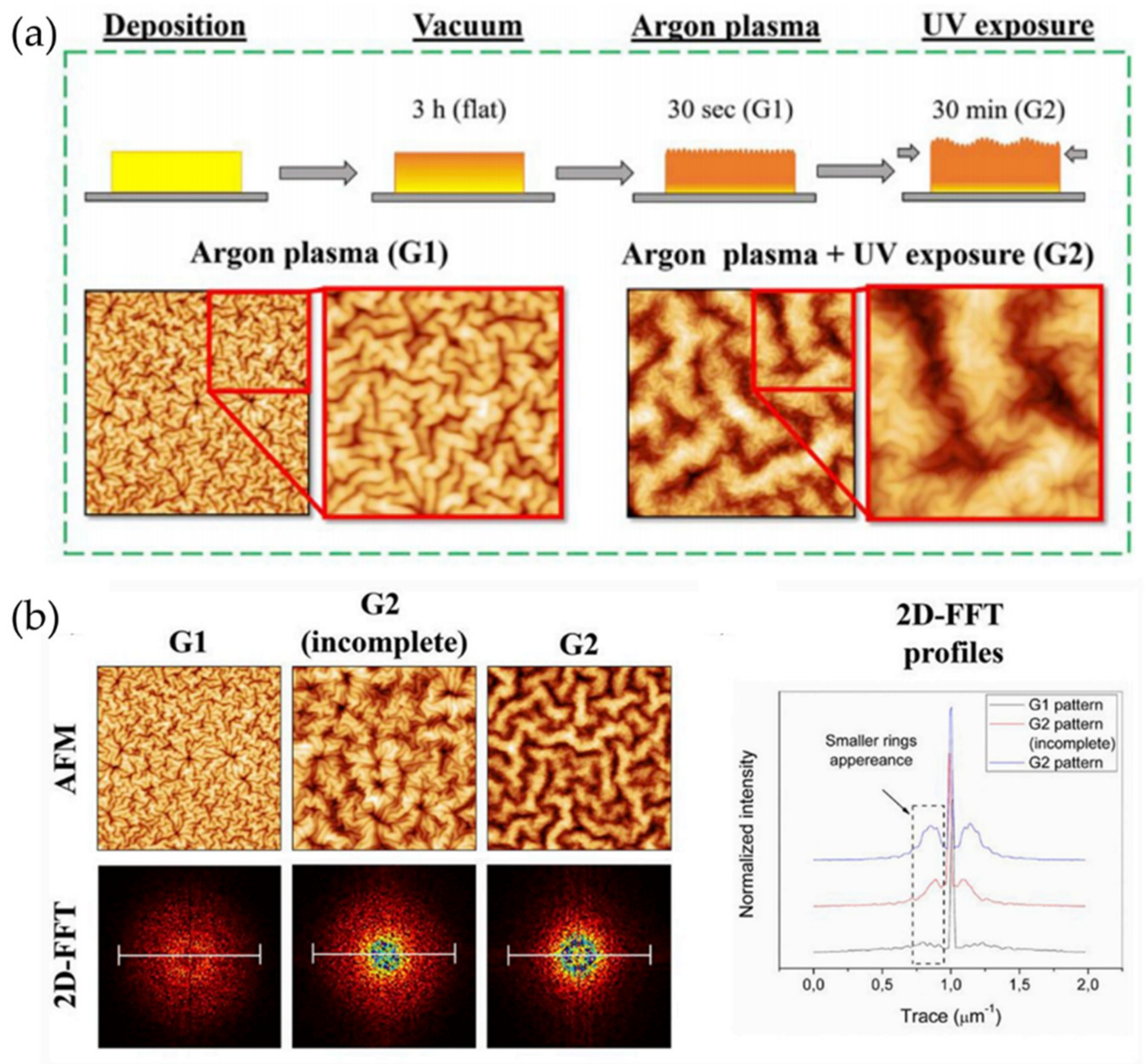

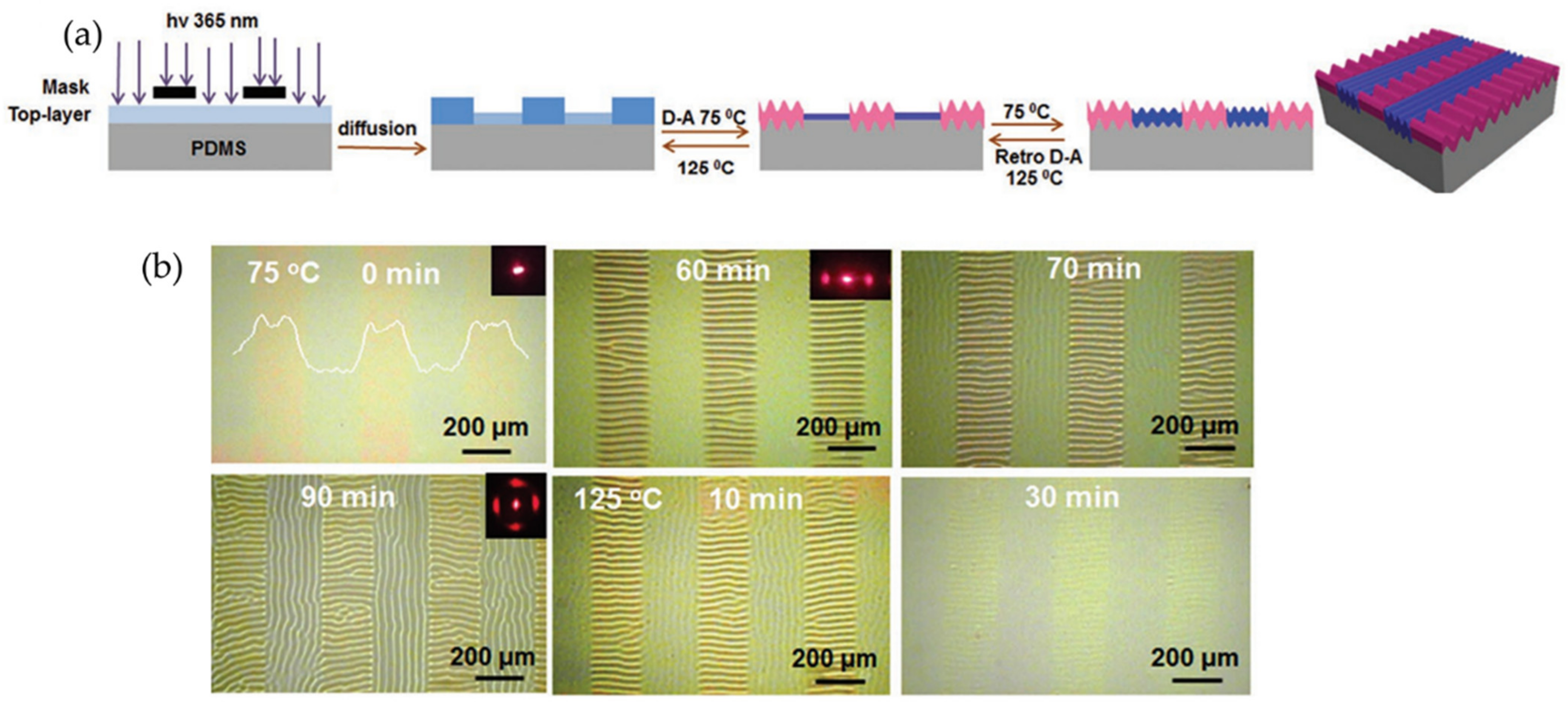


| Base Material | Responsive Light Range | Wrinkling Methodology | Posible Application | Ref. |
|---|---|---|---|---|
| Pyridine-containing azopolymer | Visible light |
| Rewritable data storage | [41,42,43] |
| Pyridine-containing polymer |
| Anti-counterfeiting | [44] | |
| Epoxy-based azobenzene |
| Rewritable data storage | [46] | |
| (POD-PS)/PDMS |
| Rewritable data storage Anti-counterfeiting | [54] | |
| PET/LAP | UV light |
| Photonic devices Cell culture patterns Flexible sensors | [49,50] |
| Silk/PDMS |
| Rewritable data storage Anti-counterfeiting | [40] | |
| CNT/PDMS/PAN | NIR light |
| Anti-counterfeiting | [51,52,53] |
| CNT/PDMS |
| Smart displays Dynamic gratings Light control electronic | [47,48] |
| Base Material | Responsive pH Range | Wrinkling Methodology | Possible Application | Ref. |
|---|---|---|---|---|
| PAA/PEG/PDMS | 2.5–7.0 |
| Tunable stress-relief patterns | [58] |
| PAA/PAH/SiO2 | 4.5–6.5 |
| Morphology-controlled smart superhydrophobic films | [57] |
| PNIPAM-co-AA/CuS | 5.6–9.2 |
| Biomimetic mineralization | [59] |
| Base Material | Responsive Temperature Range | Wrinkling Methodology | Possible Application | Ref. |
|---|---|---|---|---|
| PNIPAM and hybrid silica | RT—36°C |
| Soft micro-actuators | [61] |
| PEGDMA/tBA | RT—60 °C |
| Smart micromirror | [65] |
| PVA/PDMS | RT—80°C |
| Smart windows | [63,64] |
| PS/PEM/CL | RT—100 °C |
| Fuel cells | [66] |
| Base Material | Responsive Range | Methodology | Application | Ref. |
|---|---|---|---|---|
| PVA/PDMS | Stretching |
| Dynamic optical switching | [71] |
| PDMS | Stretching |
| Mechanochromic | [72] |
| PVP/Ir/PDMS | Stretching |
| Structural health monitoring Soft robotics | [73] |
| PDMS | Stretching |
| Portable electronics | [74] |
| PPY/PDMS | Pressure |
| Optically switchable microcircuit and photodetection | [75] |
| SU8/PDMS | Stretching |
| Advanced flexible electronics | [76] |
| PDMS | Stretching |
| Microfluidics | [78] |
Disclaimer/Publisher’s Note: The statements, opinions and data contained in all publications are solely those of the individual author(s) and contributor(s) and not of MDPI and/or the editor(s). MDPI and/or the editor(s) disclaim responsibility for any injury to people or property resulting from any ideas, methods, instructions or products referred to in the content. |
© 2023 by the authors. Licensee MDPI, Basel, Switzerland. This article is an open access article distributed under the terms and conditions of the Creative Commons Attribution (CC BY) license (https://creativecommons.org/licenses/by/4.0/).
Share and Cite
Sarabia-Vallejos, M.A.; Cerda-Iglesias, F.E.; Pérez-Monje, D.A.; Acuña-Ruiz, N.F.; Terraza-Inostroza, C.A.; Rodríguez-Hernández, J.; González-Henríquez, C.M. Smart Polymer Surfaces with Complex Wrinkled Patterns: Reversible, Non-Planar, Gradient, and Hierarchical Structures. Polymers 2023, 15, 612. https://doi.org/10.3390/polym15030612
Sarabia-Vallejos MA, Cerda-Iglesias FE, Pérez-Monje DA, Acuña-Ruiz NF, Terraza-Inostroza CA, Rodríguez-Hernández J, González-Henríquez CM. Smart Polymer Surfaces with Complex Wrinkled Patterns: Reversible, Non-Planar, Gradient, and Hierarchical Structures. Polymers. 2023; 15(3):612. https://doi.org/10.3390/polym15030612
Chicago/Turabian StyleSarabia-Vallejos, Mauricio A., Felipe E. Cerda-Iglesias, Dan A. Pérez-Monje, Nicolas F. Acuña-Ruiz, Claudio A. Terraza-Inostroza, Juan Rodríguez-Hernández, and Carmen M. González-Henríquez. 2023. "Smart Polymer Surfaces with Complex Wrinkled Patterns: Reversible, Non-Planar, Gradient, and Hierarchical Structures" Polymers 15, no. 3: 612. https://doi.org/10.3390/polym15030612




